(秦宏进)Dynamics and Stability of Plunge Milling Operation
- 格式:pdf
- 大小:1.00 MB
- 文档页数:9
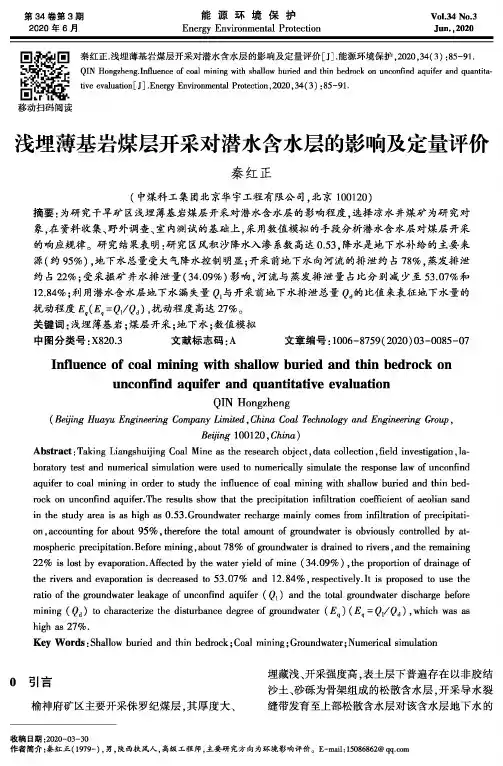
Vol.34 No.3Jun., 2020第34卷第3期2020年6月能源环境保护Energy Environmental Protection移动扫码阅读秦红正.浅埋薄基岩煤层开采对潜水含水层的影响及定量评价[J] •能源环境保护,2020,34(3) :85-91.QIN Hongzheng. I nfluence of coal mining with shallow buried and thin bedrock on unconfind aquifer and quantita tive evaluationf J].Energy Environmental Protection ,2020,34(3) :85-91.浅埋薄基岩煤层开采对潜水含水层的影响及定量评价秦红正(中煤科工集团北京华宇工程有限公司,北京100120)摘要:为研究干旱矿区浅埋薄基岩煤层开采对潜水含水层的影响程度,选择凉水井煤矿为研究对 象,在资料收集、野外调查、室内测试的基础上,采用数值模拟的手段分析潜水含水层对煤层开采 的响应规律。
研究结果表明:研究区风积沙降水入渗系数高达0.53,降水是地下水补给的主要来源(约95%),地下水总量受大气降水控制明显;开采前地下水向河流的排泄约占78%,蒸发排泄 约占22%;受采掘矿井水排泄量(34.09%)影响,河流与蒸发排泄量占比分别减少至53.07%和12.84%;利用潜水含水层地下水漏失量Q 与开采前地下水排泄总量 乞的比值来表征地下水量的扰动程度Eg = QJQ&),扰动程度高达27%。
关键词:浅埋薄基岩;煤层开采;地下水;数值模拟中图分类号:X820.3 文献标志码:A 文章编号:1006-8759(2020)03-0085-07Influence of coal mining with shallow buried and thin bedrock onunconfind aquifer and quantitative evaluationQIN Hongzheng(Beijing Huayu Engineering Company Limited , China Coal Technology and Engineering Group ,Beijing W0120,China)Abstract : Taking Liangshuijing Coal Mine as the research object , data collection , field investigation , la boratory test and numerical simulation were used to numerically simulate the response law of unconfindaquifer to coal mining in order to study the influence of coal mining with shallow buried and thin bed rock on unconfind aquifer. T he results show that the precipitation infiltration coefficient of aeolian sand in the study area is as high as 0.53. G roundwater recharge mainly comes from infiltration of precipitati on ,accounting for about 95%, therefore the total amount of groundwater is obviously controlled by at mospheric precipitation.Before mining , about 78% of groundwater is drained to rivers , and the remaining22% is lost by evaporation .Affected by the water yield of mine (34.09%) ,the proportion of drainage of the rivers and evaporation is decreased to 53.07% and 12.84%, respectively.It is proposed to use theratio of the groundwater leakage of unconfind aquifer ( Q ) and the total groundwater discharge beforemining ( ) to characterize the disturbance degree of groundwater (£q ) (£q = QJQ d ) , which was ashigh as 27%.Key Words : Shallow buried and thin bedrock ; Coal mining ; Groundwater ; Numerical simulation0引言榆神府矿区主要开采侏罗纪煤层,其厚度大、埋藏浅、开采强度高,表土层下普遍存在以非胶结 沙土、砂砾为骨架组成的松散含水层,开采导水裂 缝带发育至上部松散含水层对该含水层地下水的收稿日期:2020-03-30作者简介:秦红正(1979-),男,陕西扶风人,高级工程卯,主要研究方向为环境滲响评价。

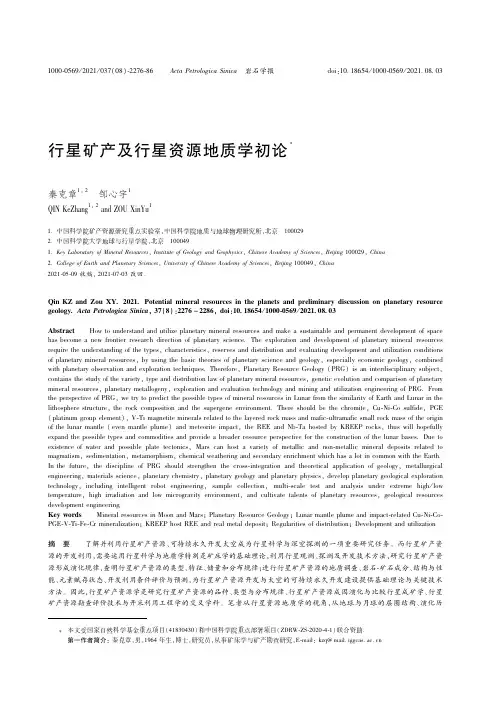
1000 0569/2021/037(08) 2276 86ActaPetrologicaSinica 岩石学报doi:10 18654/1000 0569/2021 08 03行星矿产及行星资源地质学初论秦克章1,2 邹心宇1QINKeZhang1,2andZOUXinYu11 中国科学院矿产资源研究重点实验室,中国科学院地质与地球物理研究所,北京 1000292 中国科学院大学地球与行星学院,北京 1000491 KeyLaboratoryofMineralResources,InstituteofGeologyandGeophysics,ChineseAcademyofSciences,Beijing100029,China2 CollegeofEarthandPlanetarySciences,UniversityofChineseAcademyofSciences,Beijing100049,China2021 05 09收稿,2021 07 03改回QinKZandZouXY 2021 Potentialmineralresourcesintheplanetsandpreliminarydiscussiononplanetaryresourcegeology ActaPetrologicaSinica,37(8):2276-2286,doi:10 18654/1000 0569/2021 08 03Abstract Howtounderstandandutilizeplanetarymineralresourcesandmakeasustainableandpermanentdevelopmentofspacehasbecomeanewfrontierresearchdirectionofplanetaryscience Theexplorationanddevelopmentofplanetarymineralresourcesrequiretheunderstandingofthetypes,characteristics,reservesanddistributionandevaluatingdevelopmentandutilizationconditionsofplanetarymineralresources,byusingthebasictheoriesofplanetaryscienceandgeology,especiallyeconomicgeology,combinedwithplanetaryobservationandexplorationtechniques Therefore,PlanetaryResourceGeology(PRG)isaninterdisciplinarysubject,containsthestudyofthevariety,typeanddistributionlawofplanetarymineralresources,geneticevolutionandcomparisonofplanetarymineralresources,planetarymetallogeny,explorationandevaluationtechnologyandminingandutilizationengineeringofPRG FromtheperspectiveofPRG,wetrytopredictthepossibletypesofmineralresourcesinLunarfromthesimilarityofEarthandLunarinthelithospherestructure,therockcompositionandthesupergeneenvironment Thereshouldbethechromite,Cu Ni Cosulfide,PGE(platinumgroupelement),V Timagnetitemineralsrelatedtothelayeredrockmassandmafic ultramaficsmallrockmassoftheoriginofthelunarmantle(evenmantleplume)andmeteoriteimpact,theREEandNb TahostedbyKREEProcks,thuswillhopefullyexpandthepossibletypesandcommoditiesandprovideabroaderresourceperspectivefortheconstructionofthelunarbases Duetoexistenceofwaterandpossibleplatetectonics,Marscanhostavarietyofmetallicandnon metallicmineraldepositsrelatedtomagmatism,sedimentation,metamorphism,chemicalweatheringandsecondaryenrichmentwhichhasalotincommonwiththeEarth Inthefuture,thedisciplineofPRGshouldstrengthenthecross integrationandtheoreticalapplicationofgeology,metallurgicalengineering,materialsscience,planetarychemistry,planetarygeologyandplanetaryphysics,developplanetarygeologicalexplorationtechnology,includingintelligentrobotengineering,samplecollection,multi scaletestandanalysisunderextremehigh/lowtemperature,highirradiationandlowmicrogravityenvironment,andcultivatetalentsofplanetaryresources,geologicalresourcesdevelopmentengineeringKeywords MineralresourcesinMoonandMars;PlanetaryResourceGeology;Lunarmantleplumeandimpact relatedCu Ni Co PGE V Ti Fe Crmineralization;KREEPhostREEandrealmetaldeposit;Regularitiesofdistribution;Developmentandutilization摘 要 了解并利用行星矿产资源、可持续永久开发太空成为行星科学与深空探测的一项重要研究任务。
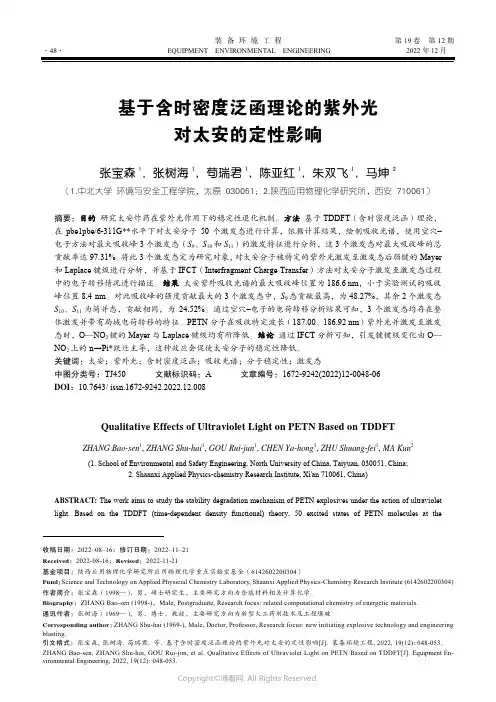
装备环境工程第19卷第12期·48·EQUIPMENT ENVIRONMENTAL ENGINEERING2022年12月基于含时密度泛函理论的紫外光对太安的定性影响张宝森1,张树海1,苟瑞君1,陈亚红1,朱双飞1,马坤2(1.中北大学 环境与安全工程学院,太原 030051;2.陕西应用物理化学研究所,西安 710061)摘要:目的研究太安炸药在紫外光作用下的稳定性退化机制。
方法基于TDDFT(含时密度泛函)理论,在pbe1pbe/6-311G**水平下对太安分子50个激发态进行计算,依据计算结果,绘制吸收光谱,使用空穴–电子方法对最大吸收峰3个激发态(S9、S10和S11)的激发特征进行分析,这3个激发态对最大吸收峰的总贡献率达97.31%。
将此3个激发态定为研究对象,对太安分子被特定的紫外光激发至激发态后弱键的Mayer 和Laplace键级进行分析,并基于IFCT(Interfragment Charge Transfer)方法对太安分子激发至激发态过程中的电子转移情况进行描述。
结果太安紫外吸收光谱的最大吸收峰位置为186.6 nm,小于实验测试的吸收峰位置8.4 nm。
对此吸收峰的强度贡献最大的3个激发态中,S9态贡献最高,为48.27%,其余2个激发态S10、S11为简并态,贡献相同,为24.52%。
通过空穴–电子的电荷转移分析结果可知,3个激发态均存在整体激发并带有局域电荷转移的特征。
PETN分子在吸收特定波长(187.00、186.92 nm)紫外光并激发至激发态时,O—NO2键的Mayer与Laplace键级均有所降低。
结论通过IFCT分析可知,引发键键级变化由O—NO2上的n→Pi*跃迁主导,这种效应会促使太安分子的稳定性降低。
关键词:太安;紫外光;含时密度泛函;吸收光谱;分子稳定性;激发态中图分类号:TJ450 文献标识码:A 文章编号:1672-9242(2022)12-0048-06DOI:10.7643/ issn.1672-9242.2022.12.008Qualitative Effects of Ultraviolet Light on PETN Based on TDDFTZHANG Bao-sen1, ZHANG Shu-hai1, GOU Rui-jun1, CHEN Ya-hong1, ZHU Shuang-fei1, MA Kun2(1. School of Environmental and Safety Engineering, North University of China, Taiyuan, 030051, China;2. Shaanxi Applied Physics-chemistry Research Institute, Xi'an 710061, China)ABSTRACT: The work aims to study the stability degradation mechanism of PETN explosives under the action of ultraviolet light. Based on the TDDFT (time-dependent density functional) theory, 50 excited states of PETN molecules at the收稿日期:2022–08–16;修订日期:2022–11–21Received:2022-08-16;Revised:2022-11-21基金项目:陕西应用物理化学研究所应用物理化学重点实验室基金(6142602200304)Fund:Science and Technology on Applied Physicial Chemistry Laboratory, Shaanxi Applied Physics-Chemistry Research Institute (6142602200304)作者简介:张宝森(1998—),男,硕士研究生,主要研究方向为含能材料相关计算化学。
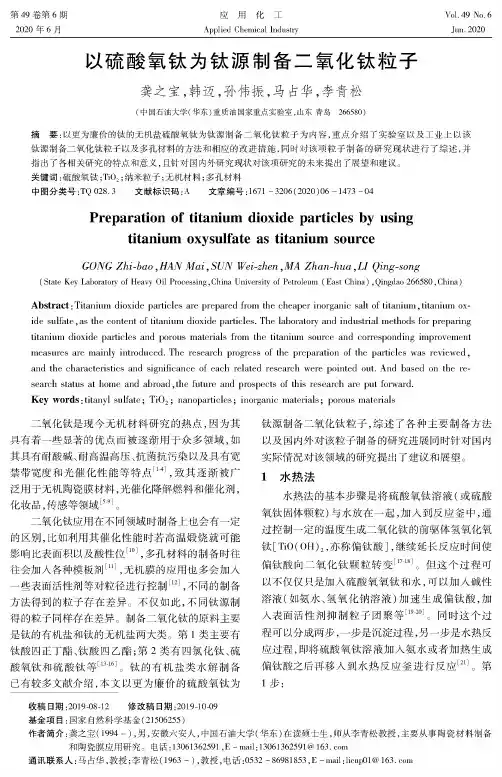
应用化工Applied Chemical Induste Vol.07No.6 Jun.2020第47卷第6期2020年6月以硫酸氧钛为钛源制备二氧化钛粒子龚之宝,韩迈,孙伟振,马占华,李青松(中国石油大学(华东)重质油国家重点实验室,山东青岛266582)摘要:以更为廉价的钛的无机盐硫酸氧钛为钛源制备二氧化钛粒子为内容,重点介绍了实验室以及工业上以该钛源制备二氧化钛粒子以及多孔材料的方法和相应的改进措施,同时对该项粒子制备的研究现状进行了综述,并指出了各相关研究的特点和意义,且针对国内外研究现状对该项研究的未来提出了展望和建议。
关键词:硫酸氧钛;TiO5;纳米粒子;无机材料;多孔材料中图分类号:TQ028.8文献标识码:A文章编号:271-3206(2020)06-273-04Preparation of titanium dioxine particles by usingtitanium oxysdfate as titanium sturccGONG Zhi-Zao,HAN Maa-SUN Weiahen,MA Zhan-juaO^Q—g-song (S/O Key Laboetoe of Heave0/Processing,China University of Petroleum(East China):Qingdao266530,China)Abstraci:Titanium dioxide pakOlas are prepareP fem the Cxpar inorganic salt of titanium,titanium oy-ife sulOta,as the coutest of titanium dioxide pakic/s.The laboratoe and indust/al methoUs for prepa/ng titanium dioxide pakiclas and porous materials from the titanium source and cooespondWg iwprovemep-meusuras are mainly intmCxced.The research pegress of the preparatiou of the pakiclas was reviewed, and the characte/sdcs and signiUcanca of each related research were pointed out.And based on the research status a-home and adead,the future and pespects of this research are put fomarb.Key wo S s:titanyi sunata;0—4;nanoparfclas,inorganic mate/als,pomus mate/als二氧化钛是现今无机材料研究的热点,因为其具有着一些显著的优点而被逐渐用于众多领域,如其具有耐酸碱、耐高温高压、抗菌抗污染以及具有宽禁带宽度和光催化性能等特点「T,致其逐渐被广泛用于无机陶瓷膜材料,光催化降解燃料和催化剂,化妆品,传感等领域匕3。
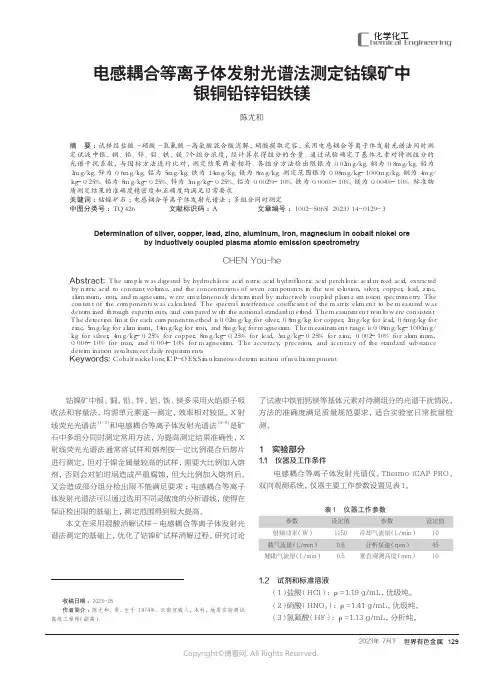
2023年 7月下 世界有色金属129化学化工C hemical Engineering电感耦合等离子体发射光谱法测定钴镍矿中银铜铅锌铝铁镁陈尤和(甘肃省有色金属地质勘查局兰州矿产勘查院,甘肃 兰州 730046)摘 要:试样经盐酸-硝酸-氢氟酸-高氯酸混合酸消解,硝酸提取定容,采用电感耦合等离子体发射光谱法同时测定试液中银、铜、铅、锌、铝、铁、镁7个组分浓度,经计算求得组分的含量。
通过试验确定了基体元素对待测组分的光谱干扰系数,与国标方法进行比对,测定结果两者相符。
各组分方法检出限银为0.02mg/kg、铜为0.8mg/kg、铅为2mg/kg、锌为0.6mg/kg、铝为5mg/kg、铁为14mg/kg、镁为8mg/kg。
测定范围银为0.08mg/kg~1000mg/kg、铜为4mg/kg~0.25%、铅为8mg/kg~0.25%、锌为3mg/kg~0.25%、铝为0.002%~10%、铁为0.006%~10%、镁为0.004%~10%。
标准物质测定结果的准确度精密度和正确度均满足日常要求。
关键词:钴镍矿石;电感耦合等离子体发射光谱法;多组分同时测定中图分类号:TQ426 文献标识码:A 文章编号:1002-5065(2023)14-0129-3Determination of silver, copper, lead, zinc, aluminum, iron, magnesium in cobalt nickel oreby inductively coupled plasma atomic emission spectrometryCHEN You-he(Lanzhou Mineral Exploration Institute of Gansu Nonferrous Metals Geological Exploration Bureau, Lanzhou 730046, China)Abstract: The sample was digested by hydrochloric acid nitric acid hydrofluoric acid perchloric acid mixed acid, extracted by nitric acid to constant volume, and the concentrations of seven components in the test solution, silver, copper, lead, zinc, aluminum, iron, and magnesium, were simultaneously determined by inductively coupled plasma emission spectrometry. The content of the components was calculated. The spectral interference coefficient of the matrix element to be measured was determined through experiments, and compared with the national standard method. The measurement results were consistent. The detection limit for each component method is 0.02mg/kg for silver, 0.8mg/kg for copper, 2mg/kg for lead, 0.6mg/kg for zinc, 5mg/kg for aluminum, 14mg/kg for iron, and 8mg/kg for magnesium. The measurement range is 0.08mg/kg~1000mg/kg for silver, 4mg/kg~0.25% for copper, 8mg/kg~0.25% for lead, 3mg/kg~0.25% for zinc, 0.002~10% for aluminum, 0.006~10% for iron, and 0.004~10% for magnesium. The accuracy, precision, and accuracy of the standard substance determination results meet daily requirements.Keywords: Cobalt nickel ore;ICP-OES;Simultaneous determination of multicomponent收稿日期:2023-05作者简介:陈尤和,男,生于1974年,云南宣威人,本科,地质实验测试高级工程师(副高)。
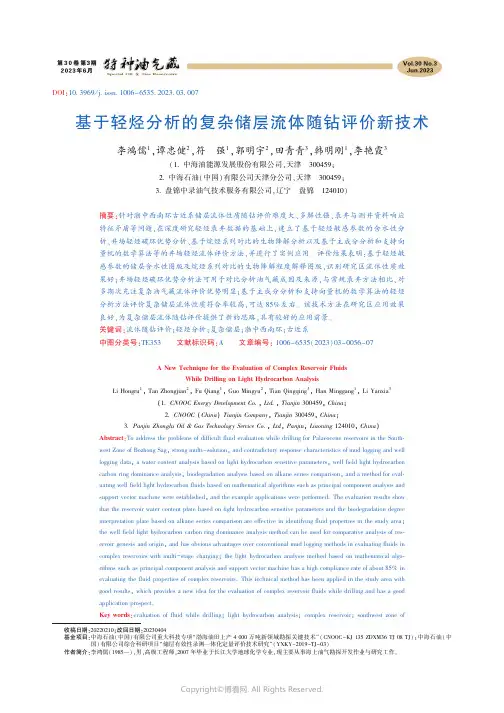
㊀㊀收稿日期:20220210;改回日期:20230404㊀㊀基金项目:中海石油(中国)有限公司重大科技专项 渤海油田上产4000万吨新领域勘探关键技术 (CNOOC -KJ 135ZDXM36TJ 08TJ);中海石油(中国)有限公司综合科研项目 储层有效性录测一体化定量评价技术研究 (YXKY -2019-TJ -03)㊀㊀作者简介:李鸿儒(1985 ),男,高级工程师,2007年毕业于长江大学地球化学专业,现主要从事海上油气勘探开发作业与研究工作㊂DOI :10.3969/j.issn.1006-6535.2023.03.007基于轻烃分析的复杂储层流体随钻评价新技术李鸿儒1,谭忠健2,符㊀强1,郭明宇2,田青青3,韩明刚1,李艳霞3(1.中海油能源发展股份有限公司,天津㊀300459;2.中海石油(中国)有限公司天津分公司,天津㊀300459;3.盘锦中录油气技术服务有限公司,辽宁㊀盘锦㊀124010)摘要:针对渤中西南环古近系储层流体性质随钻评价难度大㊁多解性强㊁录井与测井资料响应特征矛盾等问题,在深度研究轻烃录井数据的基础上,建立了基于轻烃敏感参数的含水性分析㊁井场轻烃碳环优势分析㊁基于烷烃系列对比的生物降解分析以及基于主成分分析和支持向量机的数学算法等的井场轻烃流体评价方法,并进行了实例应用㊂评价结果表明:基于轻烃敏感参数的储层含水性图版及烷烃系列对比的生物降解程度解释图版,识别研究区流体性质效果好;井场轻烃碳环优势分析法可用于对比分析油气藏成因及来源,与常规录井方法相比,对多期次充注复杂油气藏流体评价优势明显;基于主成分分析和支持向量机的数学算法的轻烃分析方法评价复杂储层流体性质符合率较高,可达85%左右㊂该技术方法在研究区应用效果良好,为复杂储层流体随钻评价提供了新的思路,具有较好的应用前景㊂关键词:流体随钻评价;轻烃分析;复杂储层;渤中西南环;古近系中图分类号:TE353㊀㊀文献标识码:A ㊀㊀文章编号:1006-6535(2023)03-0056-07A New Technique for the Evaluation of Complex Reservoir FluidsWhile Drilling on Light Hydrocarbon AnalysisLi Hongru 1,Tan Zhongjian 2,Fu Qiang 1,Guo Mingyu 2,Tian Qingqing 3,Han Minggang 1,Li Yanxia 3(OOC Energy Development Co.,Ltd.,Tianjin 300459,China ;OOC (China )Tianjin Company ,Tianjin 300459,China ;3.Panjin Zhonglu Oil &Gas Technology Service Co.,Ltd ,Panjin ,Liaoning 124010,China )Abstract :To address the problems of difficult fluid evaluation while drilling for Palaeocene reservoirs in the South-west Zone of Bozhong Sag ,strong multi -solution ,and contradictory response characteristics of mud logging and well logging data ,a water content analysis based on light hydrocarbon sensitive parameters ,well field light hydrocarbon carbon ring dominance analysis ,biodegradation analysis based on alkane series comparison ,and a method for eval-uating well field light hydrocarbon fluids based on mathematical algorithms such as principal component analysis and support vector machine were established ,and the example applications were performed.The evaluation results showthat the reservoir water content plate based on light hydrocarbon sensitive parameters and the biodegradation degree interpretation plate based on alkane series comparison are effective in identifying fluid properties in the study area ;the well field light hydrocarbon carbon ring dominance analysis method can be used for comparative analysis of res-ervoir genesis and origin ,and has obvious advantages over conventional mud logging methods in evaluating fluids in complex reservoirs with multi -stage charging ;the light hydrocarbon analysis method based on mathematical algo-rithms such as principal component analysis and support vector machine has a high compliance rate of about 85%in evaluating the fluid properties of complex reservoirs.This technical method has been applied in the study area with good results ,which provides a new idea for the evaluation of complex reservoir fluids while drilling and has a goodapplication prospect.Key words :evaluation of fluid while drilling ;light hydrocarbon analysis ;complex reservoir ;southwest zone of㊀第3期李鸿儒等:基于轻烃分析的复杂储层流体随钻评价新技术57㊀㊀Bozhong Sag;Paleocene0㊀引㊀言轻烃分析技术出现于1978年左右,Leythae-user㊁Schaefer㊁Thompson和Hunt等阐述了轻烃分析方法及其应用[1-6]㊂Mango及Ten等[7-10]形成的轻烃稳态动力学成因模型使得轻烃分析技术应用更加广泛㊂1983年以来,中国开始建立并推广轻烃分析方法,林壬子㊁张春明㊁段毅等[11-13]针对轻烃成因以及轻烃分析方法在勘探中的应用开展了广泛研究㊂近年来,轻烃录井随钻分析技术的研究与应用逐步兴起,轻烃录井分析以其检测参数丰富的特点弥补了气测录井分析的不足,且轻烃参数对油气藏信息极为敏感,在复杂储层精细评价及油气层含水识别方面具有一定的技术优势,在中国部分含油区块已经形成了一些可行的解释方法[14-15]㊂轻烃录井技术参数及其衍生参数超过200个,但常用的参数不到20个,且部分参数与储层流体性质匹配度并不高,需要深度数据挖掘技术来处理轻烃参数,提升分析评价的时效,提高分析评价的精度㊂渤中西南环位于渤中凹陷西南洼㊁南洼和中洼之间的近南北向构造脊上,成藏条件优越,是渤海海域勘探热点区域[16-17]㊂随着渤中西南环油气勘探程度不断深入,对储层认识不断深化,发现中深储层孔隙结构更加复杂且非均质性更强,油气藏类型多变[18],储层岩性㊁物性㊁流体的变化导致储层含油气性在常规录测井上响应特征不够明显,流体解释易产生多解性[19-20],给决策者带来很大困扰㊂为此,选取渤中西南环32口井㊁1398层井场轻烃数据,在前人研究基础上,通过敏感参数建立解释评价图版,结合轻烃碳环优势分析技术及数据挖掘分析技术,建立基于轻烃分析的复杂储层流体随钻评价技术,对渤中西南环古近系储层流体进行随钻评价,在实际应用中取得较好的效果㊂1㊀区域地质概况渤中西南环探区勘探面积大,探区由西南洼凹陷㊁沙南凹陷和埕北凹陷及相邻凸起和斜坡构成,是一个具有构造圈闭和岩性圈闭的有利勘探区带㊂渤中西南环探区受新构造运动影响,晚期断裂活动强烈,油气藏在浅层㊁深层均有分布㊂区域古近系发育东营组三段(东三段)㊁沙河街组一段(沙一段)㊁沙河街组二段(沙二段)㊁沙河街组三段(沙三段)等有利储层,以近源扇三角洲沉积为主㊂东营组二段(东二段)湖相泥岩与东三段扇三角洲砂体㊁沙一段顶部湖相泥岩与下部扇三角洲砂体等形成多套良好的储盖组合㊂区域古近系发育东三段㊁沙一段和沙三段3套烃源岩,烃源岩厚度为500~2500m,其中,沙三段烃源岩有机质类型以Ⅰ型为主,沙一段烃源岩有机质类型以Ⅰ㊁Ⅱ1型为主,东三段烃源岩有机质类型以Ⅱ1型为主,有机质类型好㊁丰度较高,且烃源岩在2500m附近进入生烃门限,具有较好的烃源条件㊂长期活动的断裂形成了复杂的油气运移通道,能够有效沟通不同凹陷㊁不同烃源岩所产生的油气,但同时也造成了区域内油气关系复杂,多期的油气充注㊁水洗作用及生物降解作用改变了油气藏的原始样貌㊂2㊀基于轻烃分析的复杂储层流体随钻评价技术2.1㊀井场轻烃数据标准化处理由于分析条件差异(仪器㊁预热时间等),导致轻烃谱图保留时间不一致,后期资料处理应用难度大㊂根据各谱图中相同成分的色谱峰位置对谱图进行伸缩和平移操作,结合色谱基线线性插值法,使轻烃谱图各组分保留时间一致,从而对轻烃数据进行标准化处理,将轻烃各组分数据校正到一致的时间点㊂保留时间校正保证了研究区轻烃数据的准确性,为流体准确评价奠定数据基础㊂2.2㊀复杂储层流体随钻评价常规方法的建立选取渤中西南环32口井㊁1398层古近系(东营组㊁沙河街组)储层轻烃数据,在数据标准化处理的基础上,基于轻烃敏感参数㊁井场轻烃碳环优势分析㊁烷烃系列对比生物降解分析,并结合数据挖掘技术开展含水性分析㊁生物降解分析等流体性质识别研究,建立研究区基于轻烃分析的复杂储层流体随钻评价技术,提高流体评价准确性,有效解决古近系储层随钻评价难题㊂2.2.1㊀基于轻烃敏感参数的含水性分析方法常温下,烃类在水中的溶解度很低,按溶解度㊀58㊀特种油气藏第30卷㊀由大到小排序为芳香烃㊁烷烃㊁环烷烃[21-22],Lafar-gue [23]等用4种委内瑞拉原油进行水洗实验,其结果也符合上述规律,即在水洗实验的残留油中,甲苯含量为原来的5%,庚烷含量为原来的51%,甲基环己烷含量最高,为原来的69%㊂基于以上理论基础,通过对研究区22口探井古近系油气显示储层的轻烃数据对比分析,优选出轻烃丰度及芳香烃含量参数分析古近系储层含水性,建立古近系轻烃含水性分析图版(图1)㊂由图1可知:轻烃丰度越高,反映储层含油性越好,反之,含油性越差;芳香烃含量越高,反映储层含水的可能性越小,反之,则含水的可能性越大㊂图1㊀渤中西南环古近系轻烃含水性分析图版Fig.1㊀The plate of water content analysis of Paleocenelight hydrocarbons in the southwest zone of Bozhong Sag2.2.2㊀井场轻烃碳环优势分析方法Mango 轻烃稳态催化动力学成因理论中,提出了 稳态催化反应 的轻烃成因假说和K 1㊁K 2值,对轻烃的成因㊁组成和分布特征进行了系统研究[7-8]㊂在油气成藏研究中,轻烃参数在母质来源与沉积环境㊁有机质成熟度以及油气源对比方面具有重要的价值[13]㊂Mango 提出C 7轻烃异构体形成的不同途径,称为碳环优势路径:三元环优势(3RP)路径㊁五元环优势(5RP)路径及六元环优势(6RP)路径[9]㊂利用三元环[3RP:2-甲基己烷(2MC 6)+3-甲基己烷(3MC 6)+3-乙基戊烷(3EC 5)+2,2-二甲基戊烷(2,2DMC 5)+2,3-二甲基戊烷(2,3DMC 5)+2,4-二甲基戊烷(2,4DMC 5)+3,3-二甲基戊烷(3,3DMC 5)+2,2,3-三甲基丁烷(2,2,3TMC 4)],五元环[5RP:乙基环戊烷(ECYC 5)+1,2-正-二甲基环戊烷+1,2-反-二甲基环戊烷(1,2-(c +t )-DMCYC 5)+1,1-二甲基环戊烷(1,1-DMCYC 5)+1,3-正-二甲基环戊烷+1,3-反-二甲基环戊烷(1,3-(c +t )-DM-CYC 5)]和六元环[6RP:甲苯(TOL)+甲基环己烷(MCYC 6)]相对丰度做三角图,不同沉积环境或排烃期次会产生不同优势的轻烃产物,因此,可对油气藏的成因及来源进行对比分析[10]㊂基于渤中西南环储层流体轻烃特征,开展井场油气藏成因及来源对比分析(图2)㊂由图2可知:研究区既具有六元环优势分布,也具有三元环优势分布,其中,六元环优势是该区主体油气特征;CFD21-1-C 井㊁CFD21-3-A 井及CFD16-2-A 井位于三元环优势区;CFD22-2-A 井数据点比较分散,六元环区和三元环区均有分布,显示明显的混源特征(图2)㊂利用轻烃数据进行碳环优势分析,有助于从油气藏成因等源头上解决复杂储层流体评价的难题㊂图2㊀渤中西南环井场轻烃碳环优势分析Fig.2㊀The geochemical light hydrocarbon carbon ring advantage analysis at the wellfield in the southwest zone of Bozhong Sag2.2.3㊀基于烷烃系列对比的生物降解分析方法在石油中,异构己烷按含量从大到小的排序为:2-甲基戊烷㊁3-甲基戊烷㊁2,3-二甲基丁烷㊁2,2-二甲基丁烷,当原油遭受生物降解作用时,异构己烷抗生物作用的能力与正常原油异构己烷的含量相反,通过异构己烷含量变化可识别生物降解作用的存在㊂微生物降解作用是比较复杂的生物化学过程,不同菌种优先选择消耗的对象也存在差别,一般正构烷烃最易遭受生物降解,异构和环烷烃抗生物降解能力相对较强[13],正庚烷是在所有㊀第3期李鸿儒等:基于轻烃分析的复杂储层流体随钻评价新技术59㊀㊀C 7类烃中对生物降解作用最敏感的化合物,庚烷值和异庚烷值越小,原油降解越严重[3]㊂基于以上原理,通过分析研究区20口探井古近系储层地化轻烃参数,优选出4个敏感性参数(3-甲基戊烷与2,3-二甲基丁烷相对含量比;2-甲基戊烷与2,2-二甲基丁烷相对含量比;庚烷值;异庚烷值),并形成2套古近系储层生物降解分析解释图版,如图3所示㊂该解释图版能有效区分原油和生物降解原油,对复杂流体识别效果好㊂由图3可知,CFD22-2-A 井古近系显示层落入异构烷烃生物降解识别图版生物降解油区(图3a),且CFD22-2-A 井整体较CFD21-1-A㊁CFD21-1-B㊁CFD21-1-C 及CFD15-3-A 等井受生物降解更严重,位于严重生物降解区内(图3b)㊂研究表明,渤中西南环古近系储层降解程度变化较大,流体类型复杂㊂图3㊀渤中西南环古近系生物降解识别图版Fig.3㊀The Paleocene biodegradation identification plate in the southwest zone of Bozhong Sag2.3㊀复杂储层流体随钻评价数据挖掘方法地化轻烃技术采集的原始参数和衍生参数多达223个,其蕴含丰富的地层烃类信息,应用常规方法难以进行快速全面的分析㊂为此,应用数据挖掘分析方法对渤中西南环复杂储层流体性质进行随钻评价,利用主成分分析算法形成二维和三维的交会图版,对储层流体性质进行有效识别;利用支持向量机算法对已知样本进行训练学习,从而对未知样本进行预测㊂基于上述的数据挖掘分析方法解释符合率可达到85%左右㊂2.3.1㊀主成分分析算法主成分分析算法是多元统计分析中最常见的数据分析方法㊂其原理是设法将原变量重新组合成一组新的相互无关的几个综合变量,同时,根据实际需要从中可以取出几个较少的综合变量,尽可能多地反映原变量信息的统计方法,是一种无监督的降维方法㊂利用特征权重算法,根据不同轻烃参数和流体类别的相关性赋予不同的权重,优选出含油性相关参数(轻烃总含量㊁重中烃比率)和含水性相关参数(季碳与甲基环戊烷含量比值㊁甲苯与甲基环己烷含量比值㊁甲基环己烷与正庚烷含量比值等轻烃敏感参数),采用主成分分析算法将轻烃参数进行降维,得到m 个一维矩阵(PC 1㊁PC 2 PCm ),第1个主成分(PC 1)总是体现了数据集中的最大方差,接下来的每个主成分依次具有与之前主成分正交的最大方差,因此,依次选择PC 1㊁PC 2㊁PC 3建立二维和三维的交汇图版对储层流体性质进行区分(图4)㊂PC 1=-0.6892ωTOTAL -0.1547ωMCYC 6ωn C 7-0.3458ωMCH -0.1158ωWMH +0.5889ω4CωMCYC 5+0.1459ωTOLωMCYC 6(1)PC 2=0.5329ωTOTAL -0.3328ωMCYC 6ωn C 7-0.1985ωMCH +0.5501ωWMH +0.5030ω4C ωMCYC 5+0.1008ωTOL ωMCYC 6(2)㊀60㊀特种油气藏第30卷㊀PC 3=0.0410ωTOTAL +0.0523ωMCYC 6ωn C 7+0.8410ωMCH -0.1771ωWMH +0.5000ω4CωMCYC 5+0.0834ωTOLωMCYC 6(3)式中:ωTOTAL 为轻烃总含量;ωMCC 6为甲基环己烷含量;ωn C为正庚烷含量;ωMCH 为甲基环己烷指数,%;ωWMH 为重中烃比率,%;ω4C 为季碳含量;ωMCYC 为甲基环戊烷含量;ωTOL 为甲苯含量㊂图4㊀不同流体性质地化轻烃主成分分析解释图版Fig.4㊀The interpretation plate of principal component analysis of geochemical light hydrocarbons with different fluid properties㊀㊀由图4可知:油层㊁油水同层等不同流体性质之间分类明显,易区分;基于主成分分析算法建立的图版提高了不同流体间的分离程度,可有效地识别复杂储层流体㊂2.3.2㊀支持向量机算法支持向量机算法是一种有监督的机器学习方法,即以支持向量为核心原理的机器学习分类器,属于一般化线性分类器,其决策边界是对学习样本求解的最大边距超平面㊂该方法的基本原理是将样本的低维向量非线性地隐式映射到高维特征空间,并在2个分类之间的超平面两侧建立一对互相平行的支持超平面并使其之间的距离最大化㊂支持向量是指从2个分类样本训练集中筛选得到的一组样本子集,使得对特征空间中样本子集的划分等价于对整个训练集的划分,这组用于将2个类别划分开来的超平面上的向量即为支持向量㊂利用支持向量机算法,建立储层流体性质分类训练模型及预测模型,将22个研究区古近系储层轻烃数据做为已知样本进行训练,选取CFD22-2-A 井8个待测轻烃数据样本进行结果预判:2178~2198m 为油水同层,2210~2214m㊁2250~2275m 为含油水层㊂3㊀应用效果在CFD22-2-A 井古近系储层2178~2262m井段录测井响应特征差异大:气测TG >3.0%,岩屑荧光面积为20%,壁心为灰色油浸细砂岩,含油面积为50%,荧光面积为80%,储层油气录井显示较好,常规录井现场解释为油层(图5);地化热解岩屑Pg 值为14.96mg /g,壁心Pg 值为17.20mg /g,达到油层解释标准;常规测井电阻率偏低,测井解释含水饱和度为82.0%~92.8%,为含油水层㊂利用轻烃分析方法对CFD22-2-A 井古近系储层2178~2262m 井段进行流体性质评价:轻烃丰度及芳香烃含量整体偏低,在古近系轻烃含水图版上位于含油水层区域,含水特征明显(图1);井场轻烃碳环优势分析图中数据落点比较分散(图2),六元环优势区和三元环优势区均有分布,表明油源类型复杂,油藏为多期次充注;古近系异构烷烃生物降解识别图版分析显示(图3a),其具有明显的生物降解特征,且位于庚烷值和异庚烷值生物降解识别图版的生物降解区内(图3b),整体较CFD21-1-A㊁CFD21-1-B 等井受生物降解更严重㊂CFD22-2-A 井古近系储层数据点在不同流体性质轻烃主成分分析解释图版上主要与含油水层㊀第3期李鸿儒等:基于轻烃分析的复杂储层流体随钻评价新技术61㊀㊀数据点重合(图4);利用支持向量机算法预判分类结果:CFD22-2-A 井古近系储层8个待测轻烃数据样本中有6个预判为含油水层,2个预判为油水同层㊂基于主成分分析算法及支持向量机算法的轻烃分析方法表明该段储层含水特征明显㊂综上所述,CFD22-2-A 井古近系储层含水特征明显,油藏类型复杂,具有多期次充注特征;后期受生物降解作用,原油流动性变差,从而形成残余油,导致常规录井显示活跃,显示为 油层 的假象㊂2197.5m 电缆取样见水2700cm 3,见油花,轻烃分析结果与之相符,显示出轻烃分析技术在复杂储层流体随钻评价方面具有优势㊂图5㊀CFD22-2-A 井录测井综合图Fig.5㊀The comprehensive map of mud logging and well logging of Well CFD22-2-A4㊀结㊀论(1)基于渤中西南环32口井1398层轻烃地化数据,优选轻烃敏感参数建立了渤中西南环典型区块储层含水性及生物降解程度解释图版,应用效果良好,有效解决古近系储层流体随钻评价难题㊂(2)渤中西南环13口探井井场轻烃碳环优势分析表明,六元环优势是该区主体油气特征,也具有三元环优势分布,少数井分散在六元环优势区及三元环优势区之间,呈现出明显的混源特征㊂渤中西南环地区油源类型复杂,多油源多期次充注现象明显㊂(3)渤中西南环部分井古近系储层成藏后期受生物降解作用导致油质变重,油品变差,原油流动性变差,从而形成残余油,导致常规录井显示活跃,显示为 油层 的假象㊂(4)运用主成分分析及支持向量机数学算法,实现了机器学习算法与轻烃录井解释应用的深度融合,建立了井场轻烃油气水解释新技术,解释符合率可达到85%左右,但该方法还需进一步探索技术背后的地质意义㊂参考文献[1]LEYTHAEUSER D,SCHAEFER R G,CORNFORD C,et al.Generation and migration of light hydrocarbons(C 2-C 7)in sedimenta-ry basins[J].Organic geochemistry,1979,1(4):191-204.[2]THOMPSON K F M.Light hydrocarbons in subsurface sediments [J].Geochimica et Cosmochimica Acta,1979,43(5):657-672.[3]THOMPSON K F M.Classification and thermal history of petrole-um based on light hydrocarbons[J].Geochimica et Cosmochimica Acta,1983,47(2):303-316.[4]THOMPSON K F M.Fractionated aromatic petroleums and thegeneration of gas -condensates[J].Organic geochemistry,1987,11(6):573-590.㊀62㊀特种油气藏第30卷㊀[5]THOMPSON K F M.Gas -condensate migration and oil fractiona-tion in deltaic systems[J].Marine and Petroleum Geology,1988,5(3):237-246.[6]HUNT J M.Generation and migration of light hydrocarbons[J].Science,1984,226(4680):1265-1270.[7]MANGO F D.An invariance in the isoheptanes of petroleum[J].Science,1987,237(4814):514-517.[8]MANGO F D.The origin of light cycloalkanes in petroleum[J].Geochimica et Cosmochimica Acta,1990,54(1):23-27.[9]MANGO F D.The origin of light hydrocarbons in petroleum:ringpreference in the closure of carbocyclic rings[J].Geochimica etCosmochimica Acta,1994,58(2):895-901.[10]TEN Haven H L.Applications and limitations of Mangoᶄs light hy-drocarbon parameters in petroleum correlation studies[J].Organ-ic Geochemistry,1996,24(10/11):957-976.[11]林壬子,张敏,徐中一.轻质油中C 1-C 7轻烃的地球化学特征[J].江汉石油学院学报,1989,11(1):10-16.LIN Renzi,ZHANG Min,XU Zhongyi.Geochemistry characteris-tics of light hydrocarbons (C 1-C 7)in light oils [J].Journal ofJianghan Petroleum Institute,1989,11(1):10-16.[12]张春明.石油中轻烃的成因及其应用[J].石油天然气学报,2005,27(2):146-148.ZHANG Chunming.Origin and application of light hydrocarbonsin petroleum[J].Journal of Oil and Gas Technology,2005,27(2):146-148.[13]段毅,赵阳,姚泾利,等.轻烃地球化学研究进展及发展趋势[J].天然气地球科学,2014,25(12):1875-1887.DUAN Yi,ZHAO Yang,YAO Jingli,et al.Research advance andtendency of light hydrocarbon geochemistry[J].Natural Gas Geo-science,2014,25(12):1875-1887.[14]吴长金,马昌伟,张可操.轻烃分析录井技术在海拉尔盆地的应用[J].中国工程科学,2012,14(4):49-57.WU Changjin,MA Changwei,ZHANG Kecao.Application of lighthydrocarbon analysis logging in Hailar Basin[J].Strategic Study of CAE,2012,14(4):49-57.[15]韩明刚,谭忠健,李鸿儒,等.轻烃参数在埕北低凸起复杂储集层流体随钻评价中的应用[J].录井工程,2020,31(4):98-102.HAN Minggang,TAN Zhongjian,LI Hongru,et al.Application oflight hydrocarbon parameters in complex reservoir fluids evalua-tion while drilling in Chengbei Low Uplift[J].Mud Logging Engi-neering,2020,31(4):98-102.[16]薛永安.认识创新推动渤海海域油气勘探取得新突破渤海海域近年主要勘探进展回顾[J].中国海上油气,2018,30(2):1-8.XUE Yongan.New breakthroughs in hydrocarbon exploration inthe Bohai sea area driven by understanding innovation:a review of major exploration progresses of Bohai Sea Area in recent years [J].China Offshore Oil and Gas,2018,30(2):1-8.[17]叶涛,牛成民,王清斌,等.渤海湾盆地大型基岩潜山储层特征及其控制因素 以渤中19-6凝析气田为例[J].地质学报,2021,95(6):1889-1902.YE Tao,NIU Chengmin,WANG Qingbin,et al.Characteristicsand controlling factors of large bedrock buried -hill reservoirs inthe Bohai Bay Basin:a case study of the BZ19-6condensate field[J].Acta Geologica Sinica,2021,95(6):1889-1902.[18]李鸿儒,谭忠健,胡云,等.渤中凹陷西南环M 构造太古界潜山油气藏流体类型随钻识别方法[J].油气地质与采收率,2021,28(5):22-31.LI Hongru,TAN Zhongjian,HU Yun,et al.Reservoir fluid type i-dentification while drilling for Archaeozoic buried hill reservoir ofM Structure at southwest margin of Bozhong Sag,Bohai Sea,east China[J].Petroleum Geology and Recovery Efficiency,2021,28(5):22-31.[19]谭忠健,胡云,张国强,等.渤中19-6构造复杂储层流体评价及产能预测[J].石油钻采工艺,2018,40(6):764-774.TAN Zhongjian,HU Yun,ZHANG Guoqiang,et al.Fluid evalua-tion and productivity prediction on complex reservoirs in Bozhong19-6Structure[J].Oil Drilling &Production Technology,2018,40(6):764-774.[20]叶小明,王鹏飞,霍春亮,等.海上复杂碎屑岩储层油气藏地质建模关键技术[J].中国海上油气,2018,30(3):110-115.YE Xiaoming,WANG Pengfei,HUO Chunliang,et al.Key tech-niques for geological modeling of offshore complex clastic rock reservoirs[J].China Offshore Oil and Gas,2018,30(3):110-115.[21]OBERMAJER M,OSADETZ K G,FOWLER M G,et al.Light hy-drocarbon (gasoline range)parameter refinement of biomarker -based oil -oil correlation studies:an example from Williston Basin [J].Organic Geochemistry,2000,31(10):959-976.[22]徐志明,王廷栋,姜平,等.原油水洗作用与高凝固点原油的成因探讨[J].地球化学,2000,29(6):556-561.XU Zhiming,WANG Tingdong,JIANG Ping,et al.Probe on thewater washing with genesis of high solidifying point crude oil[J].Geochimica,2000,29(6):556-561.[23]LAFARGUE E,BARKER C.Effect of water washing on crude oilcompositions[J].AAPG Bulletin,1988,72(3):263-276.编辑㊀王㊀琳。
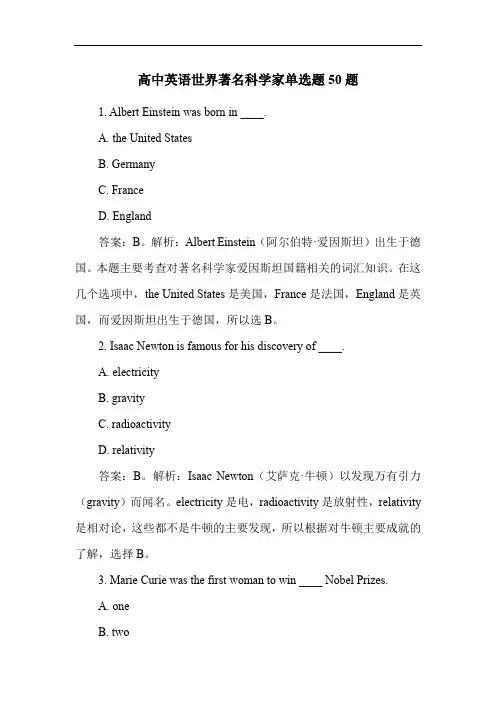
高中英语世界著名科学家单选题50题1. Albert Einstein was born in ____.A. the United StatesB. GermanyC. FranceD. England答案:B。
解析:Albert Einstein(阿尔伯特·爱因斯坦)出生于德国。
本题主要考查对著名科学家爱因斯坦国籍相关的词汇知识。
在这几个选项中,the United States是美国,France是法国,England是英国,而爱因斯坦出生于德国,所以选B。
2. Isaac Newton is famous for his discovery of ____.A. electricityB. gravityC. radioactivityD. relativity答案:B。
解析:Isaac Newton 艾萨克·牛顿)以发现万有引力gravity)而闻名。
electricity是电,radioactivity是放射性,relativity 是相对论,这些都不是牛顿的主要发现,所以根据对牛顿主要成就的了解,选择B。
3. Marie Curie was the first woman to win ____ Nobel Prizes.A. oneB. twoC. threeD. four答案:B。
解析:Marie Curie 居里夫人)是第一位获得两项诺贝尔奖的女性。
这题主要考查数字相关的词汇以及对居里夫人成就的了解,她在放射性研究等方面的贡献使她两次获得诺贝尔奖,所以选B。
4. Thomas Edison is well - known for his invention of ____.A. the telephoneB. the light bulbC. the steam engineD. the computer答案:B。
解析:Thomas Edison( 托马斯·爱迪生)以发明电灯(the light bulb)而闻名。
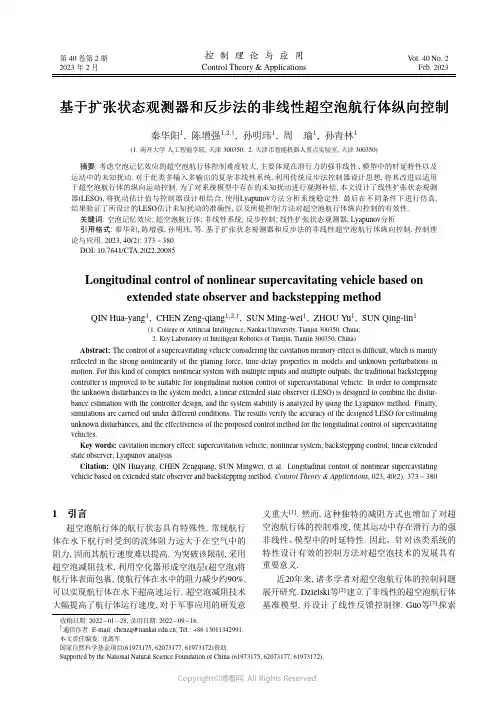
第40卷第2期2023年2月控制理论与应用Control Theory&ApplicationsV ol.40No.2Feb.2023基于扩张状态观测器和反步法的非线性超空泡航行体纵向控制秦华阳1,陈增强1,2,†,孙明玮1,周瑜1,孙青林1(1.南开大学人工智能学院,天津300350;2.天津市智能机器人重点实验室,天津300350)摘要:考虑空泡记忆效应的超空泡航行体控制难度较大,主要体现在滑行力的强非线性、模型中的时延特性以及运动中的未知扰动.对于此类多输入多输出的复杂非线性系统,利用传统反步法控制器设计思想,将其改进以适用于超空泡航行体的纵向运动控制.为了对系统模型中存在的未知扰动进行观测补偿,本文设计了线性扩张状态观测器(LESO),将扰动估计值与控制器设计相结合,使用Lyapunov方法分析系统稳定性.最后在不同条件下进行仿真,结果验证了所设计的LESO估计未知扰动的准确性,以及所提控制方法对超空泡航行体纵向控制的有效性.关键词:空泡记忆效应;超空泡航行体;非线性系统;反步控制;线性扩张状态观测器;Lyapunov分析引用格式:秦华阳,陈增强,孙明玮,等.基于扩张状态观测器和反步法的非线性超空泡航行体纵向控制.控制理论与应用,2023,40(2):373–380DOI:10.7641/CTA.2022.20085Longitudinal control of nonlinear supercavitating vehicle based on extended state observer and backstepping methodQIN Hua-yang1,CHEN Zeng-qiang1,2,†,SUN Ming-wei1,ZHOU Yu1,SUN Qing-lin1(1.College of Artificial Intelligence,Nankai University,Tianjin300350,China;2.Key Laboratory of Intelligent Robotics of Tianjin,Tianjin300350,China)Abstract:The control of a supercavitating vehicle considering the cavitation memory effect is difficult,which is mainly reflected in the strong nonlinearity of the planing force,time-delay properties in models and unknown perturbations in motion.For this kind of complex nonlinear system with multiple inputs and multiple outputs,the traditional backstepping controller is improved to be suitable for longitudinal motion control of supercavitational vehicle.In order to compensate the unknown disturbances in the system model,a linear extended state observer(LESO)is designed to combine the distur-bance estimation with the controller design,and the system stability is analyzed by using the Lyapunov method.Finally, simulations are carried out under different conditions.The results verify the accuracy of the designed LESO for estimating unknown disturbances,and the effectiveness of the proposed control method for the longitudinal control of supercavitating vehicles.Key words:cavitation memory effect;supercavitation vehicle;nonlinear system;backstepping control;linear extended state observer;Lyapunov analysisCitation:QIN Huayang,CHEN Zengqiang,SUN Mingwei,et al.Longitudinal control of nonlinear supercavitating vehicle based on extended state observer and backstepping method.Control Theory&Applications,023,40(2):373–3801引言超空泡航行体的航行状态具有特殊性.常规航行体在水下航行时受到的流体阻力远大于在空气中的阻力,因而其航行速度难以提高.为突破该限制,采用超空泡减阻技术,利用空化器形成空泡层(超空泡)将航行体表面包裹,使航行体在水中的阻力减少约90%,可以实现航行体在水下超高速运行.超空泡减阻技术大幅提高了航行体运行速度,对于军事应用的研发意义重大[1].然而,这种独特的减阻方式也增加了对超空泡航行体的控制难度,使其运动中存在滑行力的强非线性、模型中的时延特性.因此,针对该类系统的特性设计有效的控制方法对超空泡技术的发展具有重要意义.近20年来,诸多学者对超空泡航行体的控制问题展开研究.Dzielski等[2]建立了非线性的超空泡航行体基准模型,并设计了线性反馈控制律.Guo等[3]探索收稿日期:2022−01−28;录用日期:2022−09−16.†通信作者.E-mail:*****************.cn;Tel.:+86130****2991.本文责任编委:龙离军.国家自然科学基金项目(61973175,62073177,61973172)资助.Supported by the National Natural Science Foundation of China(61973175,62073177,61973172).374控制理论与应用第40卷了空化数对航行体动力学特性的影响,提供了线性反馈控制律设计依据.Mao等[4]考虑航行体的非线性控制,解决执行器饱和问题,设计了滑模控制器和线性变参数控制器.李洋等[5]建立了非全包裹超空泡航行体模型,提出了基于反步法的滑模控制律,实现了对超空泡航行体的纵向控制.Wang等[6]针对全包裹超空泡航行体提出了自适应滑模控制器,可以对模型的不确定和未知扰动做出估计.张珂等[7]应用圆柱后体的水洞试验方法,对滑行水动力进行测量实验.范春永等[8]对超空泡航行体的侧方来流对航行体的影响进行了研究,结果表明在受侧方来流冲击时,航行体的相对来流速度决定航行体所受阻力以及空泡形变大小.李洋等[9]研究了超空泡航行体的不确定性问题,基于Lyapunov分析,利用反演控制设计航行体的姿轨控制器,提出了神经网络与自适应控制相结合的控制方法.文献[10]设计了一种变增益鲁棒控制方法,通过增加松弛变量和Lyapunov函数来降低控制系统的保守性和实现系统稳定性,仿真结果表明该系统具有较强的抗干扰性能和鲁棒性.文献[11]设计了线性二次调节器和鲁棒反演控制两类控制器,并通过仿真验证了其有效性.针对模型中存在的时延问题,庞爱平等[12–13]通过对比时滞模型与非时滞模型的仿真曲线,验证了其根据非时滞设计的控制器同样适应于时滞模型.目前已有工作取得了一定效果,但考虑空泡记忆效应的超空泡航行体是涉及多参量、多输入与多输出的复杂非线性时延系统,与其他复杂非线性系统[14–15]不同,其非线性和时延特性主要体现在滑行力的计算上,尾舵与空化器偏转角作为控制输入会同时影响系统的状态,存在耦合特性.然而,控制的核心问题是抑制系统中未知扰动或者不确定性的负面作用[16].为解决此问题,Han[17]提出了自抗扰控制(active disturban-ce rejection control,ADRC),其关键思想是设计扩张状态观测器(extended state observer,ESO),从被控对象的输入或输出信号中提取未知扰动信息,并在控制中进行扰动补偿,可以明显降低扰动带来的负面影响.为便于参数整定,Gao[18]将ADRC简化为线性自抗扰控制(linear active disturbance rejection control,LAD-RC),设计了线性扩张状态观测器(linear extended sta-te observer,LESO),上述工作促进了各领域学者对ADRC的研究与应用[19–26].超空泡航行体运行过程中会受到未知扰动影响,借鉴ADRC的思想,为了估计超空泡航行体运行过程中的未知扰动,设计了基于该系统的LESO.进一步尝试采用较为简单的反步法设计控制器,通过Lyapunov 方法分析系统稳定性.通过与文献[3]中基于极点配置的线性反馈控制方法进行对比仿真,结果验证了所提方法的有效性,对于非线性超空泡航行体的纵向运动,能实现较高的控制品质.2超空泡航行体的非线性动力学模型考虑超空泡航行体在俯仰纵向平面内的运动,首先建立航行体坐标系,其原点位于航行体空化器的顶端面圆心,x轴沿航行体中心轴指向前,z轴垂直于x轴指向下,以地面系为惯性系,z为航行体深度,θ为俯仰角,w为纵向速度且沿航行体z轴方向,q为俯仰角速度,纵向平面内航行体x轴方向速度近似等于空化器的合速度V,并假设为常值,设FΛo=FΛg+FΛp[1L]T,其中FΛp为滑行力F p标准化后的值,定义如下:FΛp=−V2mL(1+h′1+2h′)[1−(R′h′+R′)2]αp,(1)FΛg=791736Lg.(2)根据Dzielski提出的经典基准模型[2],超空泡航行体的俯仰平面动力学方程如下:˙z=w−Vθ,˙θ=q,M[˙w˙q]=A[wq]+B[δfδc]+FΛo,(3)其中:A=CV1−nmL−nm+79C−nm−nLm+1736CL,B=CV2−nmL1mL−nm,M=791736L1736L1160R2+133405L2,δf为尾舵偏转角,δc为空化器偏转角,C=12C x0(1+σ)(R nR)2,(4) R′=(R c−R)/R,(5)K a=LR n(1.92σ−3)−1−1,(6)K b=[1−(1−4.5σ1+σ)K40/17a]1/2,(7) R c=R n[0.82(1+σ)σ]1/2K b.(8)第2期秦华阳等:基于扩张状态观测器和反步法的非线性超空泡航行体纵向控制375考虑空泡的记忆效应,浸入深度h ′和浸入角αp 都是含有状态时延变量的函数,设R 0=R −R c ,z ′(t,τ)=z (t )+θ(t )L −z (t −τ),根据Vanek 的文献[27],其计算公式如下:h ′= 1R [z ′(t,τ)+R ′],上壁接触,0,无接触,1R [R ′−z ′(t,τ)],下壁接触,(9)αp =θ(t )−θ(t −τ)+w (t −τ)−˙R c V,上壁接触,0,无接触,θ(t )−θ(t −τ)+w (t −τ)+˙R c V,下壁接触.(10)3种情形的判断条件为上壁接触,−R 0<z ′(t,τ),无接触,其他,下壁接触,R 0>z ′(t,τ),(11)其中:τ=L /V 表示时间延迟的值,˙Rc 表示空泡半径收缩率,表达式如下:˙R c =−2017(0.821+σσ)1/2V (1−4.5σ1+σ)K 23/17aK b (1.92σ−3).(12)采用超空泡航行体的模型参数见表1.表1超空泡航行体模型参数Table 1Supercavitating vehicle model parameters名称参数值重力加速度g 9.81(m ·s −2)航行体半径R 0.0508m 航行体长度L 1.8m密度比m 2尾翼效率n 0.5升力系数C x00.82空化器半径R n 0.0191m 空化数σ0.02413基于LESO 的反步法控制器设计与稳定性分析由第2节可知,超空泡航行体是涉及多参量,多输入与多输出的复杂非线性时延系统,其非线性和时延特性主要体现在滑行力F p 的计算上,此外,控制输入δf 和δc 会同时影响系统的状态,存在耦合特性.上述特性大大增加了对系统的控制器设计难度,利用反步法,基于Lyapunov 分析,可以在保证系统稳定性的同时有效简化控制器设计,对于系统中的未知扰动,设计LESO 进行扰动观测并补偿.在系统模型(3)中,M 为非奇异矩阵,为便于描述,令x 1=[z θ]T ,x 2=[w q ]T ,考虑系统中存在未知扰动D =[d 1d 2]T ,可将式(3)改写为{˙x 1=A 1x 1+x 2,˙x 2=A 2x 2+B 1u +F gp +D,(13)其中:A 1=[0−V00],A 2=M −1A,B 1=M −1B,u =[δf δc ]T ,F gp=M −1(F Λg +F Λp [1L]).设跟踪指令为x 1d =[z d θd ]T ,(14)跟踪误差为E 1=x 1d −x 1,对E 1求导可得˙E 1=˙x 1d −A 1x 1−x 2,(15)由于扰动项D 未知,将D 作为扩张状态x 3,有{˙x 2=A 2x 2+B 1u +F gp +x 3,˙x 3=˙D,(16)为估计未知扰动D ,构建对应的二阶LESO 如下:e 1=Z 1−x 2,˙Z 1=Z 2+A 2x 2+B 1u +F gp −β1e 1,˙Z 2=−β2e 1,(17)其中:Z 1和Z 2分别为状态变量x 2和未知扰动D 的估计值;β1=2ωo ,β2=ω2o ,ωo 为观测器带宽;假设未知扰动˙D有界,则由文献[18]可知,当t →∞时,有Z 1→x 2,Z 2→D.设虚拟指令x 2d =˙x 1d −A 1x 1+K 1E 1,(18)误差E 2=x 2d −x 2.假设˙x 1d ,¨x 1d 可获知,设计控制律u =B −11(E 1+¨x 1d +K 1˙x 1d −(A 1+K 1)˙x 1−A 2x 2−F gp −Z 2+K 2E 2),(19)其中K 1,K 2均为二阶正定矩阵.下面证明在控制律(19)下,系统(13)是渐近稳定的.证定义Lyapunov 候选函数V =12E T 1E 1+12E T2E 2,(20)则V 0,对V 求导有376控制理论与应用第40卷˙V =E T 1˙E 1+E T 2˙E 2=E T 1(˙x 1d −A 1x 1−x 2)+E T 2˙E 2=E T 1(˙x 1d −A 1x 1−x 2d +E 2)+E T 2˙E 2=−E T 1K 1E 1+E T 1E 2+E T 2˙E 2=−E T 1K 1E 1+E T 2(E 1+˙E 2)=−E T 1K 1E 1−E T 2K 2E 2<0.(21)故V 满足李雅普诺夫定理,系统(13)渐近稳定.证毕.图1为系统的控制原理框图.图1控制原理框图Fig.1Control block diagram4仿真结果为测试所提反步法控制律(19)和LESO(17)观测未知扰动的有效性,使用Simulink 进行仿真,设计不同情形的未知扰动D =[d 1d 2]T ,与文献[3]中的极点配置线性反馈法进行对比,该方法对应本文模型的控制律如下:u =−(B T B )−1B T (C +Ax d )−K f ˜x ,其中:x d =[z d θd 00]T ,˜x =x −x d ,反馈矩阵K f使用极点配置法计算得到,仿真中将极点配置为−2,−3,−4,−5.预设系统(13)的状态变量初值[z 0θ0w 0q 0]T =[0030.02]T ,跟踪指令x 1d =[z d θd ]T =[10]T ,考虑实际中舵角的限幅特性,仿真设定尾舵偏角δf 和空化器转角δc 的范围均为±25◦,根据经验选取观测器带宽ωo =10,K 1=[30080],K 2=[800015].情形1未知扰动D =[00]T .理想情况下,模型中不存在未知扰动,此时仿真结果如图2–6所示.图2中,由于系统状态初值较大,出现了大小约为500N 的非线性滑行力,在控制器作用下,该滑行力快速消失,4种状态均可在2s 内收敛并稳定至期望值(见图3),控制过程中尾舵偏角和空化器转角都能保证在限幅范围内(见图4–5).图6中,LESO 所估计未知扰动的量级在10−6,接近于0,这与未知扰动为0的情形符合,此时,有无LESO 的反步法控制效果几乎一致,而极点配置线性反馈法存在超调现象.图2情形1–滑行力变化曲线Fig.2F plane curves of Case1(a)深度(b)俯仰角(c)纵向速度(d)俯仰角速度图3情形1状态变化曲线Fig.3State curves of Case 1第2期秦华阳等:基于扩张状态观测器和反步法的非线性超空泡航行体纵向控制377图4情形1–δf 变化曲线Fig.4δf curves of Case1图5情形1–δc 变化曲线Fig.5δc curves of Case1Z 2图6情形1–LESO 估计未知扰动Fig.6Z 2curves of Case 1情形2未知扰动D =[103]T .将模型中的未知扰动设置为常数值,仿真结果如图7–11所示.由于此时极点配置线性反馈法控制下的系统失稳发散,因此仅在图7(a)中绘制了失稳状态下的深度曲线.图8中,由于系统初值和未知扰动的存在,导致滑行力初值达到600N,在反步法控制作用下,非线性滑行力会快速消失.由图7和图11可知,系统状态仍能在2s 内收敛,利用所设计的LESO 可以准确估计未知扰动,加入LESO 补偿未知扰动的反步法控制器可以消除由扰动引起的稳态误差,使系统状态更精确地达到期望值.将图9–10与情形1中的图4–5对比可知,要抵消扰动的作用需要更大的舵角变化范围,由于扰动为常数值,当系统达到稳态时,控制量也会稳定于常值,这与经验相符.对比结果表明,所提方法具有较好的鲁棒性.(a)深度(b)俯仰角(c)纵向速度(d)俯仰角速度图7情形2–状态变化曲线Fig.7State curves of Case2图8情形2–滑行力变化曲线Fig.8F plane curves of Case 2情形3未知扰动D =[10sin t 3sin t ]T .将模型中的未知扰动设置为随时间变化的正弦信号,仿真结果如图12–16所示.378控制理论与应用第40卷图13中,滑行力在控制器作用下,能从较大的初值500N 快速衰减至0.对照图12–16可知,LESO 可以较为准确地估计未知时变扰动,加入扰动补偿后的反步法控制效果更好,可以明显减弱由谐波扰动带来的振荡现象,能使系统在2s 内达到稳态.此外,结合情形1–2不难发现,空化器转角对航行体的俯仰角影响较大,尾舵偏角主要作用于航行体的升降运动,与实际情况相符.而对比方法控制下的系统无法抑制正弦扰动带来的影响,未能将系统状态收敛至期望值.图9情形2–δf 变化曲线Fig.9δf curves of Case2图10情形2–δc 变化曲线Fig.10δc curves of Case2Z 2图11情形2–LESO 估计未知扰动Fig.11Z 2curves of Case2(a)深度(b)俯仰角(c)纵向速度(d)俯仰角速度图12情形3–状态变化曲线Fig.12State curves of Case3图13情形3–滑行力变化曲线Fig.13F plane curves of Case3图14情形3–δf 变化曲线Fig.14δf curves of Case 3第2期秦华阳等:基于扩张状态观测器和反步法的非线性超空泡航行体纵向控制379图15情形3–δc 变化曲线Fig.15δc curves of Case3Z 2图16情形3–LESO 估计未知扰动Fig.16Z 2curves of Case 3综合3种情形下的对比仿真结果可知,所设计基于LESO 的反步控制方法可以精确估计并补偿系统中存在的未知扰动,对于非线性超空泡航行体的纵向运动,能够实现较高的控制品质.5结论考虑非线性超空泡航行体的纵向控制问题,主要难点:空泡记忆效应产生滑行力的强非线性、耦合特性以及模型中存在的未知不确定性.为了降低控制难度,设计了基于LESO 的反步法控制器,使用李雅普诺夫方法分析系统稳定性.在不同的未知扰动情形下进行对比仿真,结果验证了所提方法的有效性.未来工作可以考虑:优化所提控制器的参数,以达到更优的控制效果;将所提控制器改进完善并应用于其他复杂非线性系统.参考文献:[1]PANG Aiping,HE Zhen,WANG Jinghua,et al.H ∞state feedbackdesign for supercavitating vehicles.Control Theory &Applications ,2018,35(2):146–152.(庞爱平,何朕,王京华,等.超空泡航行体H ∞状态反馈设计.控制理论与应用,2018,35(2):146–152.)[2]DZIELSKI J,KURDILA A.A benchmark control problem for super-cavitating vehicles and an initial investigation of solutions.Journal of Vibration and Control ,2003,9(7):791–804.[3]GUO J,BALACHANDRAN B,ABED E H.Dynamics and control ofsupercavitating vehicles.Journal of Dynamic Systems,Measurement,and Control ,2008,130(2):021003.[4]MAO X,WANG Q.Nonlinear control design for a supercavitatingvehicle.IEEE Transactions on Control Systems Technology ,2009,17(4):816–832.[5]LI Yang,LIU Mingyong,YANG Panpan,et al.Modeling andattitude-orbit control for incomplete-encapsulated supercavitating ve-hicles.Control Theory &Applications ,2017,34(7):885–894.(李洋,刘明雍,杨盼盼,等.非全包裹超空泡航行体建模与姿轨控制.控制理论与应用,2017,34(7):885–894.)[6]WANG J,LIU Y ,CAO G,et al.Design of RBF adaptive sliding modecontroller for supercavitating vehicle.IEEE Access ,2021,9:39873–39883.[7]ZHANG Ke,LI Peng,WANG Zhi,et al.Experimental study of plan-ning force on supercavitating vehicle tail.Journal of Ship Mechanics ,2020,24(1):8–17.(张珂,李鹏,王志,等.超空泡航行体尾部滑行力实验研究.船舶力学,2020,24(1):8–17.)[8]FAN Chunyong,LI Zengliang,LIU Bin.Investigation of the influ-ence of lateral flow on the supercavitation for underwater puter Simulation ,2019,36(7):182–186.(范春永,李增亮,刘斌.水下航行体在侧方来流作用下超空化现象研究.计算机仿真,2019,36(7):182–186.)[9]LI Yang,LIU Mingyong,ZHANG Xiaojian.Adaptive RBF neuralnetwork based backsteppting control for supercavitating vehicles.Ac-ta Automatica Sinica ,2020,46(4):734–743.(李洋,刘明雍,张小件.基于自适应RBF 神经网络的超空泡航行体反演控制.自动化学报,2020,46(4):734–743.)[10]HAN Yuntao,CHENG Zhanglong,LI Panpan,et al.Robust vari-able gain control for supercavitating vehicle based on LPV .Journal of Huazhong University of Science and Technology (Natural Science Edition),2017,45(7):127–132.(韩云涛,程章龙,李盼盼,等.超空泡航行体LPV 鲁棒变增益控制.华中科技大学学报(自然科学版),2017,45(7):127–132.)[11]ZHANG X,WEI Y ,HAN Y ,et al.Design and comparison of LQRand a novel robust backstepping controller for supercavitating vehi-cles.Transactions of the Institute of Measurement and Control ,2017,39(2):149–162.[12]PANG Aiping,HE Zhen,CHAO Fan,et al.Time delay aanlysisfor supercavitating vehicles.Control Engineering of China ,2019,26(12):2241–2245.(庞爱平,何朕,钞凡,等.超空泡航行体时滞特性分析.控制工程,2019,26(12):2241–2245.)[13]HE Zhen,PANG Aiping.Feedback control design for supercavitatingvehicles.Electric Machines and Control ,2017,21(8):101–108.(何朕,庞爱平.超空泡航行体的反馈控制设计.电机与控制学报,2017,21(8):101–108.)[14]LONG L J.Synchronous vs asynchronous switching-based output-feedback control for switched nonlinear systems with measurement noise sensitivity.Systems &Control Letters ,2021,152:104935.[15]LUO H,SUN Z D,SUN W J,et al.Modeling of dielectrophoreticforces and electrorotational torque towards nonlinear control of mi-cromanipulation system.The 35th Chinese Control Conference (CC-C).Chengdu,China:2016:1135–1140.[16]GAO Zhiqiang.Research on thought of ADRC.Control Theory &Applications ,2013,30(12):1498–1510.(高志强.自抗扰控制思想探究.控制理论与应用,2013,30(12):1498–1510.)[17]HAN J Q.From PID to active disturbance rejection control.IEEETransactions on Industrial Electronics ,2009,56(3):900–906.[18]GAO Z Q.Scaling and bandwidth-parameterization based controllertuning.Proceedings of the 2003American Control Conference .Den-ver,CO,USA:IEEE,2003:4989–4996.[19]LI Jie,QI Xiaohui,WAN Hui,et al.Active disturbance rejection con-trol:Summary and prospect of research results.Control Theory &Applications ,2017,34(3):281–295.(李杰,齐晓慧,万慧,等.自抗扰控制:研究成果总结与展望.控制理论与应用,2017,34(3):281–295.)380控制理论与应用第40卷[20]CHEN Sen,XUE Wenchao,HUANG Yi.Adrc design and controlallocation for thrust vector aircraft.Control Theory&Applications, 2018,35(11):1591–1600.(陈森,薛文超,黄一.推力矢量飞行器的自抗扰控制设计及控制分配.控制理论与应用,2018,35(11):1591–1600.)[21]CHEN Zengqiang,WANG Yongshuai,SUN Mingwei,et al.Globalasymptotic stability of auto-disturbance rejection control for second-order nonlinear systems.Control Theory&Applications,2018, 35(11):1687–1696.(陈增强,王永帅,孙明玮,等.二阶非线性系统自抗扰控制的全局渐近稳定性.控制理论与应用,2018,35(11):1687–1696.)[22]LIU Junjie,CHEN Zengqiang,SUN Mingwei,et al.Application ofactive disturbance rejection control in high-angle-of-attack maneuver for aircraft with thrust vector.Chinese Journal of Engineering,2019, 41(9):1187–1193.(刘俊杰,陈增强,孙明玮,等.自抗扰控制在推力矢量飞机大迎角机动中的应用.工程科学学报,2019,41(9):1187–1193.)[23]ZHONG Sheng,HUANG Yi,HU Jinchang.Active disturbance re-jection control for deep space spacecraft attitude.Control Theory& Applications,2019,36(12):2028–2034.(钟声,黄一,胡锦昌.深空探测航天器姿态的自抗扰控制.控制理论与应用,2019,36(12):2028–2034.)[24]LIU Shengfei,SUN Qinglin,CHEN Zengqiang,et al.Anti-distur-bance commutation hysteresis compensation backstep control for proportional valve-controlled electro-hydraulic systems.Control Theory&Applications,2020,37(7):1521–1534.(刘胜斐,孙青林,陈增强,等.比例阀控电液系统抗扰换向滞后补偿反步控制.控制理论与应用,2020,37(7):1521–1534.)[25]TAN Panlong,QIN Huayang,SUN Mingwei,et al.Sliding mode ac-tive disturbance rejection control for underactuated RTAC.Control Theory&Applications,2021,38(12):2085–2093.(檀盼龙,秦华阳,孙明玮,等.欠驱动RTAC的滑模自抗扰镇定控制.控制理论与应用,2021,38(12):2085–2093.)[26]QIN Huayang,CHEN Zengqiang,SUN Mingwei,et al.Extended s-tate observer based on sliding window real-time wavelet denoising and active disturbance rejection control.Control Theory&Applica-tions,2022,39(1):23–30.(秦华阳,陈增强,孙明玮,等.基于滑动窗实时小波降噪的扩张状态观测器及自抗扰控制.控制理论与应用,2022,39(1):23–30.)[27]V ANEK B,BOKOR J,BALAS G J,et al.Longitudinal motioncontrol of a high-speed supercavitation vehicle.Journal of Vibration and Control,2007,13(2):159–184.作者简介:秦华阳硕士研究生,目前研究方向为超空泡航行体建模与控制、自抗扰控制、智能控制;陈增强教授,博士生导师,目前研究方向为智能控制、预测控制、自抗扰控制,E-mail:*****************.cn;孙明玮教授,博士生导师,目前研究方向为飞行器制导与控制、自抗扰控制;周瑜硕士研究生,目前研究方向为超空泡航行体建模与控制;孙青林教授,博士生导师,目前研究方向为自抗扰控制、自适应控制、嵌入式控制系统、柔性飞行器建模与控制.。
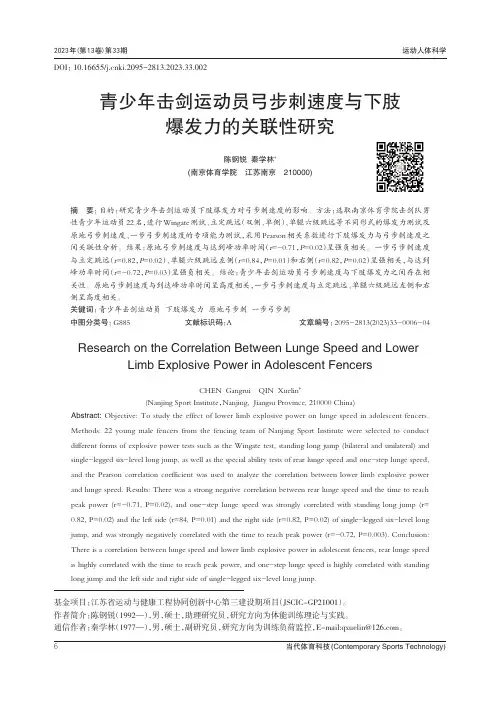
DOI: 10.16655/ki.2095-2813.2023.33.002青少年击剑运动员弓步刺速度与下肢爆发力的关联性研究(南京体育学院江苏南京210000)摘要: 目的:研究青少年击剑运动员下肢爆发力对弓步刺速度的影响。
方法:选取南京体育学院击剑队男性青少年运动员22名,进行Wingate测试、立定跳远(双侧、单侧)、单腿六级跳远等不同形式的爆发力测试及原地弓步刺速度、一步弓步刺速度的专项能力测试,采用Pearson相关系数进行下肢爆发力与弓步刺速度之间关联性分析。
结果:原地弓步刺速度与达到峰功率时间(r=-0.71,P=0.02)呈强负相关。
一步弓步刺速度与立定跳远(r=0.82,P=0.02)、单腿六级跳远左侧(r=0.84,P=0.01)和右侧(r=0.82,P=0.02)呈强相关,与达到峰功率时间(r=-0.72,P=0.03)呈强负相关。
结论:青少年击剑运动员弓步刺速度与下肢爆发力之间存在相关性。
原地弓步刺速度与到达峰功率时间呈高度相关,一步弓步刺速度与立定跳远、单腿六级跳远左侧和右侧呈高度相关。
关键词:青少年击剑运动员 下肢爆发力 原地弓步刺 一步弓步刺中图分类号:G885文献标识码:A文章编号:2095-2813(2023)33-0006-04 Research on the Correlation Between Lunge Speed and Lower Limb Explosive Power in Adolescent FencersCHEN Gangrui QIN Xuelin*(Nanjing Sport Institute,Nanjing, Jiangsu Province, 210000 China) Abstract: Objective: To study the effect of lower limb explosive power on lunge speed in adolescent fencers.Methods: 22 young male fencers from the fencing team of Nanjing Sport Institute were selected to conduct different forms of explosive power tests such as the Wingate test, standing long jump (bilateral and unilateral) and single-legged six-level long jump, as well as the special ability tests of rear lunge speed and one-step lunge speed, and the Pearson correlation coefficient was used to analyze the correlation between lower limb explosive power and lunge speed. Results: There was a strong negative correlation between rear lunge speed and the time to reach peak power (r=-0.71, P=0.02), and one-step lunge speed was strongly correlated with standing long jump (r=0.82, P=0.02) and the left side (r=84, P=0.01) and the right side (r=0.82, P=0.02) of single-legged six-level longjump, and was strongly negatively correlated with the time to reach peak power (r=-0.72, P=0.003). Conclusion:There is a correlation between lunge speed and lower limb explosive power in adolescent fencers, rear lunge speedis highly correlated with the time to reach peak power, and one-step lunge speed is highly correlated with standinglong jump and the left side and right side of single-legged six-level long jump.基金项目:江苏省运动与健康工程协同创新中心第三建设期项目(JSCIC-GP21001)。
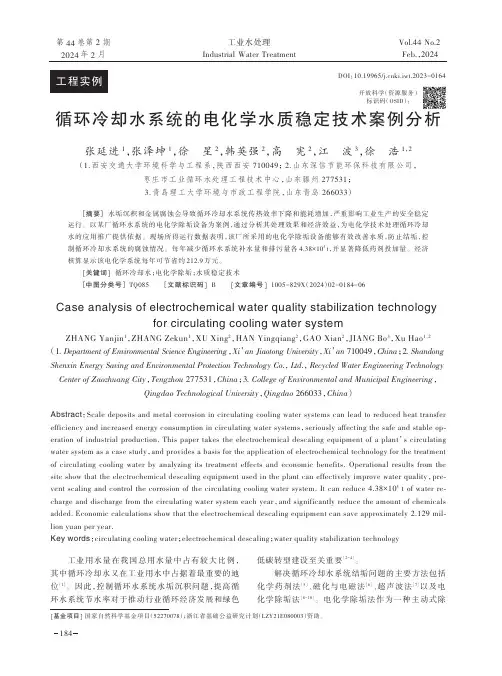
DOI :10.19965/ki.iwt.2023-0164第 44 卷第 2 期2024年 2 月Vol.44 No.2Feb.,2024工业水处理Industrial Water Treatment 循环冷却水系统的电化学水质稳定技术案例分析张延进1,张泽坤1,徐星2,韩英强2,高宪2,江波3,徐浩1,2(1.西安交通大学环境科学与工程系,陕西西安 710049; 2.山东深信节能环保科技有限公司,枣庄市工业循环水处理工程技术中心,山东滕州 277531; 3.青岛理工大学环境与市政工程学院,山东青岛 266033)[摘要]水垢沉积和金属腐蚀会导致循环冷却水系统传热效率下降和能耗增加,严重影响工业生产的安全稳定运行。
以某厂循环水系统的电化学除垢设备为案例,通过分析其处理效果和经济效益,为电化学技术处理循环冷却水的应用推广提供依据。
现场所得运行数据表明,该厂所采用的电化学除垢设备能够有效改善水质,防止结垢,控制循环冷却水系统的腐蚀情况。
每年减少循环水系统补水量和排污量各4.38×105 t ,并显著降低药剂投加量。
经济核算显示该电化学系统每年可节省约212.9万元。
[关键词] 循环冷却水;电化学除垢;水质稳定技术[中图分类号] TQ085 [文献标识码]B [文章编号] 1005-829X (2024)02-0184-06Case analysis of electrochemical water quality stabilization technologyfor circulating cooling water systemZHANG Yanjin 1,ZHANG Zekun 1,XU Xing 2,HAN Yingqiang 2,GAO Xian 2,JIANG Bo 3,Xu Hao 1,2(1.Department of Environmental Science Engineering ,Xi ’an Jiaotong University ,Xi ’an 710049,China ;2.Shandong Shenxin Energy Saving and Environmental Protection Technology Co., L td., R ecycled Water Engineering Technology Center of Zaozhuang City ,Tengzhou 277531,China ;3.College of Environmental and Municipal Engineering ,Qingdao Technological University ,Qingdao 266033,China )Abstract :Scale deposits and metal corrosion in circulating cooling water systems can lead to reduced heat transfer efficiency and increased energy consumption in circulating water systems ,seriously affecting the safe and stable op⁃eration of industrial production. This paper takes the electrochemical descaling equipment of a plant ’s circulating water system as a case study ,and provides a basis for the application of electrochemical technology for the treatment of circulating cooling water by analyzing its treatment effects and economic benefits. Operational results from the site show that the electrochemical descaling equipment used in the plant can effectively improve water quality ,pre⁃vent scaling and control the corrosion of the circulating cooling water system. It can reduce 4.38×105 t of water re⁃charge and discharge from the circulating water system each year ,and significantly reduce the amount of chemicalsadded. Economic calculations show that the electrochemical descaling equipment can save approximately 2.129 mil⁃lion yuan per year.Key words :circulating cooling water ;electrochemical descaling ;water quality stabilization technology工业用水量在我国总用水量中占有较大比例,其中循环冷却水又在工业用水中占据着最重要的地位〔1〕。
期刊全称JCR 期刊简称ISSN所属小类所属小类(中文)小类分区Annual Review of Marine Science ANNU REV MA 1941-1405GEOCHEMIST 地球化学与地球1Annual Review of Marine Science ANNU REV MA 1941-1405OCEANOGRAP 海洋学1Annual Review of Marine Science ANNU REV MA 1941-1405MARINE & FR 海洋与淡水生物1ATMOSPHERIC CHEMISTRY AND PHYSICS A TMOS CHEM 1680-7316METEOROLOG 气象与大气科学1BULLETIN OF THE AMERICAN METEOROLO B AM METEOR 0003-0007METEOROLOG 气象与大气科学1CLIMATE DYNAMICS CLIM DYNAM 0930-7575METEOROLOG 气象与大气科学2EARTH AND PLANETARY SCIENCE LETTER EARTH PLANE 0012-821XGEOCHEMIST 地球化学与地球2EARTH-SCIENCE REVIEWS EARTH-SCI RE 0012-8252GEOSCIENCES 地球科学综合1Geochemical Perspectives GEOCHEM PER 2223-7755GEOCHEMIST 地球化学与地球1GEOCHIMICA ET COSMOCHIMICA ACTA GEOCHIM COS 0016-7037GEOCHEMIST 地球化学与地球2GEOLOGICAL SOCIETY OF AMERICA BULL GEOL SOC AM 0016-7606GEOSCIENCES 地球科学综合1GEOLOGY GEOLOGY 0091-7613GEOLOGY 地质学1Geoscientific Model Development GEOSCI MODE 1991-959XGEOSCIENCES 地球科学综合1GONDWANA RESEARCH GONDWANA R 1342-937XGEOSCIENCES 地球科学综合1Journal of Advances in Modeling Earth SystemsJ ADV MODEL 1942-2466METEOROLOG 气象与大气科学2JOURNAL OF CLIMATE J CLIMATE 0894-8755METEOROLOG 气象与大气科学2JOURNAL OF PETROLOGY J PETROL 0022-3530GEOCHEMIST 地球化学与地球1Nature Geoscience NAT GEOSCI 1752-0894GEOSCIENCES 地球科学综合1PRECAMBRIAN RESEARCH PRECAMBRIA 0301-9268GEOSCIENCES 地球科学综合1QUATERNARY SCIENCE REVIEWS QUATERNARY 0277-3791GEOSCIENCES 地球科学综合1QUATERNARY SCIENCE REVIEWS QUATERNARY 0277-3791GEOGRAPHY,自然地理2REVIEWS OF GEOPHYSICS REV GEOPHYS 8755-1209GEOCHEMIST 地球化学与地球1AMERICAN JOURNAL OF SCIENCE AM J SCI 0002-9599GEOSCIENCES 地球科学综合2APPLIED CLAY SCIENCE APPL CLAY SC 0169-1317MATERIALS S 材料科学:综合3APPLIED CLAY SCIENCE APPL CLAY SC 0169-1317MINERALOGY 矿物学3APPLIED CLAY SCIENCE APPL CLAY SC 0169-1317CHEMISTRY, P 物理化学3Atmospheric Measurement Techniques ATMOS MEAS 1867-1381METEOROLOG 气象与大气科学2BASIN RESEARCH BASIN RES 0950-091XGEOSCIENCES 地球科学综合2BULLETIN OF VOLCANOLOGY B VOLCANOL 0258-8900GEOSCIENCES 地球科学综合3CHEMICAL GEOLOGY CHEM GEOL 0009-2541GEOCHEMIST 地球化学与地球2Climate of the Past CLIM PAST 1814-9324GEOSCIENCES 地球科学综合2Climate of the Past CLIM PAST 1814-9324METEOROLOG 气象与大气科学2CONTRIBUTIONS TO MINERALOGY AND PE CONTRIB MIN 0010-7999GEOCHEMIST 地球化学与地球2CONTRIBUTIONS TO MINERALOGY AND PE CONTRIB MIN 0010-7999MINERALOGY 矿物学2Cryosphere CRYOSPHERE 1994-0416GEOSCIENCES 地球科学综合2Cryosphere CRYOSPHERE 1994-0416GEOGRAPHY,自然地理2DEEP-SEA RESEARCH PART I-OCEANOGRA DEEP-SEA RES 0967-0637OCEANOGRAP 海洋学2EARTH SURFACE PROCESSES AND LANDFO EARTH SURF P 0197-9337GEOSCIENCES 地球科学综合2EARTH SURFACE PROCESSES AND LANDFO EARTH SURF P 0197-9337GEOGRAPHY,自然地理3Earth System Dynamics EARTH SYST D 2190-4979GEOSCIENCES 地球科学综合2Elements ELEMENTS 1811-5209GEOCHEMIST 地球化学与地球2Elements ELEMENTS 1811-5209MINERALOGY 矿物学2GEOCHEMISTRY GEOPHYSICS GEOSYSTEM GEOCHEM GE 1525-2027GEOCHEMIST 地球化学与地球2GEOMORPHOLOGY GEOMORPHOL 0169-555XGEOSCIENCES 地球科学综合2GEOMORPHOLOGY GEOMORPHOL 0169-555XGEOGRAPHY,自然地理3GEOPHYSICAL JOURNAL INTERNATIONAL GEOPHYS J IN 0956-540XGEOCHEMIST 地球化学与地球3GEOPHYSICAL RESEARCH LETTERS GEOPHYS RES 0094-8276GEOSCIENCES 地球科学综合2GEOSTANDARDS AND GEOANALYTICAL RE GEOSTAND GE 1639-4488GEOCHEMIST 地球化学与地球3HOLOCENE HOLOCENE 0959-6836GEOSCIENCES 地球科学综合2HOLOCENE HOLOCENE 0959-6836GEOGRAPHY,自然地理2HYDROLOGY AND EARTH SYSTEM SCIENC HYDROL EAR 1027-5606GEOSCIENCES 地球科学综合2HYDROLOGY AND EARTH SYSTEM SCIENC HYDROL EAR 1027-5606WATER RESOU 水资源1INTERNATIONAL GEOLOGY REVIEW INT GEOL REV 0020-6814GEOLOGY 地质学2INTERNATIONAL JOURNAL OF CLIMATOLO INT J CLIMAT 0899-8418METEOROLOG 气象与大气科学3JOURNAL OF GEODESY J GEODESY 0949-7714GEOCHEMIST 地球化学与地球2JOURNAL OF GEODESY J GEODESY 0949-7714REMOTE SENS 遥感2JOURNAL OF GEODYNAMICS J GEODYN 0264-3707GEOCHEMIST 地球化学与地球3JOURNAL OF GEOLOGY J GEOL 0022-1376GEOLOGY 地质学2JOURNAL OF GEOPHYSICAL RESEARCH J GEOPHYS RE 0148-0227GEOSCIENCES 地球科学综合2JOURNAL OF GLACIOLOGY J GLACIOL 0022-1430GEOSCIENCES 地球科学综合2JOURNAL OF GLACIOLOGY J GLACIOL 0022-1430GEOGRAPHY,自然地理3JOURNAL OF HYDROLOGY J HYDROL 0022-1694GEOSCIENCES 地球科学综合2JOURNAL OF HYDROLOGY J HYDROL 0022-1694ENGINEERING 工程:土木1JOURNAL OF HYDROLOGY J HYDROL 0022-1694WATER RESOU 水资源2JOURNAL OF HYDROMETEOROLOGY J HYDROMETE 1525-755XMETEOROLOG 气象与大气科学2JOURNAL OF METAMORPHIC GEOLOGY J METAMORPH 0263-4929GEOLOGY 地质学1JOURNAL OF PHYSICAL OCEANOGRAPHY J PHYS OCEAN 0022-3670OCEANOGRAP 海洋学2JOURNAL OF QUATERNARY SCIENCE J QUATERNAR 0267-8179GEOSCIENCES 地球科学综合2JOURNAL OF QUATERNARY SCIENCE J QUATERNAR 0267-8179GEOGRAPHY,自然地理3JOURNAL OF SYSTEMATIC PALAEONTOLO J SYST PALAE 1477-2019PALEONTOLO 古生物学2JOURNAL OF SYSTEMATIC PALAEONTOLO J SYST PALAE1477-2019EVOLUTIONA进化生物学4J ATMOS SCI0022-4928METEOROLOGJOURNAL OF THE ATMOSPHERIC SCIENCES3气象与大气科学JOURNAL OF THE GEOLOGICAL SOCIETYJ GEOL SOC LO0016-7649GEOSCIENCES地球科学综合20024-3590OCEANOGRAP LIMNOLOGY AND OCEANOGRAPHY LIMNOL OCEA海洋学20024-3590LIMNOLOGY湖沼学1 LIMNOLOGY AND OCEANOGRAPHY LIMNOL OCEA2 LITHOS LITHOS0024-4937GEOCHEMIST地球化学与地球LITHOS LITHOS0024-4937MINERALOGY矿物学130027-0644METEOROLOG MONTHLY WEATHER REVIEW MON WEATHE气象与大气科学OCEAN MODELLING OCEAN MODE1463-5003OCEANOGRAP海洋学23 OCEAN MODELLING OCEAN MODE1463-5003METEOROLOG气象与大气科学1042-8275OCEANOGRAP OCEANOGRAPHY OCEANOGRAP海洋学2 ORE GEOLOGY REVIEWS ORE GEOL RE0169-1368GEOLOGY地质学2 ORE GEOLOGY REVIEWS ORE GEOL RE0169-1368MINERALOGY矿物学2 ORE GEOLOGY REVIEWS ORE GEOL RE0169-1368MINING & MIN1矿业与矿物加工3 ORGANIC GEOCHEMISTRY ORG GEOCHE0146-6380GEOCHEMIST地球化学与地球PALAEOGEOGRAPHY PALAEOCLIMATOLO P ALAEOGEOG0031-0182GEOSCIENCES地球科学综合20031-0182PALEONTOLO古生物学2 PALAEOGEOGRAPHY PALAEOCLIMATOLO P ALAEOGEOG0031-0182GEOGRAPHY,自然地理3 PALAEOGEOGRAPHY PALAEOCLIMATOLO P ALAEOGEOG0094-8373PALEONTOLO古生物学1 PALEOBIOLOGY PALEOBIOLOG0094-8373EVOLUTIONA进化生物学4 PALEOBIOLOGY PALEOBIOLOG0094-8373ECOLOGY生态学3 PALEOBIOLOGY PALEOBIOLOG3 PALEOBIOLOGY PALEOBIOLOG0094-8373BIODIVERSITY生物多样性保护PALEOCEANOGRAPHY PALEOCEANO0883-8305GEOSCIENCES地球科学综合2 PALEOCEANOGRAPHY PALEOCEANO0883-8305PALEONTOLO古生物学1 PALEOCEANOGRAPHY PALEOCEANO0883-8305OCEANOGRAP海洋学2 PERMAFROST AND PERIGLACIAL PROCESS PERMAFROST1045-6740GEOLOGY地质学2 PERMAFROST AND PERIGLACIAL PROCESS PERMAFROST1045-6740GEOGRAPHY,自然地理30079-6611OCEANOGRAP PROGRESS IN OCEANOGRAPHY PROG OCEANO海洋学1 PROGRESS IN PHYSICAL GEOGRAPHY PROG PHYS G0309-1333GEOSCIENCES地球科学综合2 PROGRESS IN PHYSICAL GEOGRAPHY PROG PHYS G0309-1333GEOGRAPHY,自然地理22 QUARTERLY JOURNAL OF THE ROYAL MET0035-9009METEOROLOGQ J ROY METE气象与大气科学Quaternary Geochronology QUAT GEOCH1871-1014GEOSCIENCES地球科学综合2 Quaternary Geochronology QUAT GEOCH1871-1014GEOGRAPHY,自然地理21529-6466GEOCHEMIST地球化学与地球2REV MINERALREVIEWS IN MINERALOGY & GEOCHEMIST1529-6466MINERALOGYREV MINERALREVIEWS IN MINERALOGY & GEOCHEMIST矿物学2 SEDIMENTOLOGY SEDIMENTOL0037-0746GEOLOGY地质学2SEISMOLOGICAL RESEARCH LETTERS SEISMOL RES 0895-0695GEOCHEMIST地球化学与地球320169-3298GEOCHEMIST地球化学与地球SURVEYS IN GEOPHYSICS SURV GEOPHY2 TECTONICS TECTONICS0278-7407GEOCHEMIST地球化学与地球0040-1951GEOCHEMIST地球化学与地球3 TECTONOPHYSICS TECTONOPHY2TELLUS B0280-6509METEOROLOGTELLUS SERIES B-CHEMICAL AND PHYSICA气象与大气科学0567-7920PALEONTOLO古生物学3 ACTA PALAEONTOLOGICA POLONICA ACTA PALAEOADVANCES IN GEOPHYSICS ADV GEOPHY0065-2687GEOSCIENCES地球科学综合43 AMERICAN MINERALOGIST AM MINERAL0003-004X GEOCHEMIST地球化学与地球AMERICAN MINERALOGIST AM MINERAL0003-004X MINERALOGY矿物学3 ANNALES GEOPHYSICAE ANN GEOPHY0992-7689GEOSCIENCES地球科学综合34 ANNALES GEOPHYSICAE ANN GEOPHY0992-7689METEOROLOG气象与大气科学ANNALES GEOPHYSICAE ANN GEOPHY0992-7689ASTRONOMY 天文与天体物理40260-3055GEOSCIENCESANNALS OF GLACIOLOGY ANN GLACIOL地球科学综合3 ANNALS OF GLACIOLOGY ANN GLACIOL0260-3055GEOGRAPHY,自然地理4 ANTARCTIC SCIENCE ANTARCT SCI0954-1020GEOSCIENCES地球科学综合3 ANTARCTIC SCIENCE ANTARCT SCI0954-1020ENVIRONMEN环境科学4 ANTARCTIC SCIENCE ANTARCT SCI0954-1020GEOGRAPHY,自然地理43 APPLIED GEOCHEMISTRY APPL GEOCHE0883-2927GEOCHEMIST地球化学与地球4 AQUATIC GEOCHEMISTRY AQUAT GEOC1380-6165GEOCHEMIST地球化学与地球1075-2196GEOSCIENCES Archaeological Prospection ARCHAEOL PR地球科学综合3 ATMOSPHERE-OCEAN ATMOS OCEA0705-5900OCEANOGRAP海洋学4 ATMOSPHERE-OCEAN ATMOS OCEA0705-5900METEOROLOG4气象与大气科学3 ATMOSPHERIC RESEARCH ATMOS RES0169-8095METEOROLOG气象与大气科学41530-261X METEOROLOG Atmospheric Science Letters ATMOS SCI LE气象与大气科学BOREAS BOREAS0300-9483GEOSCIENCES地球科学综合3 BOREAS BOREAS0300-9483GEOGRAPHY,自然地理33 BOUNDARY-LAYER METEOROLOGY BOUND-LAY M0006-8314METEOROLOG气象与大气科学30037-1106GEOCHEMIST地球化学与地球B SEISMOL SOBULLETIN OF THE SEISMOLOGICAL SOCIETCLIMATE RESEARCH CLIM RES0936-577X ENVIRONMEN环境科学3 CLIMATE RESEARCH CLIM RES0936-577X METEOROLOG3气象与大气科学COMPTES RENDUS GEOSCIENCE CR GEOSCI1631-0713GEOSCIENCES地球科学综合3 COMPUTERS & GEOSCIENCES COMPUT GEO0098-3004GEOSCIENCES地球科学综合33 COMPUTERS & GEOSCIENCES COMPUT GEO0098-3004COMPUTER SC计算机:跨学科0278-4343OCEANOGRAP CONTINENTAL SHELF RESEARCH CONT SHELF R海洋学3 CRETACEOUS RESEARCH CRETACEOUS0195-6671GEOLOGY地质学3 CRETACEOUS RESEARCH CRETACEOUS0195-6671PALEONTOLO古生物学2DEEP-SEA RESEARCH PART II-TOPICAL STU0967-0645OCEANOGRAPDEEP-SEA RES海洋学240377-0265GEOCHEMIST地球化学与地球DYNAMICS OF ATMOSPHERES AND OCEANDYNAM ATMODYNAM ATMO0377-0265OCEANOGRAP DYNAMICS OF ATMOSPHERES AND OCEAN海洋学40377-0265METEOROLOG DYNAMICS OF ATMOSPHERES AND OCEAN4DYNAM ATMO气象与大气科学Earth Interactions EARTH INTER1087-3562GEOSCIENCES地球科学综合33 ECONOMIC GEOLOGY ECON GEOL0361-0128GEOCHEMIST地球化学与地球ENGINEERING GEOLOGY ENG GEOL0013-7952GEOSCIENCES地球科学综合4 ENGINEERING GEOLOGY ENG GEOL0013-7952ENGINEERING工程:地质2ESTUAR COAS0272-7714OCEANOGRAP ESTUARINE COASTAL AND SHELF SCIENCE海洋学330272-7714MARINE & FR海洋与淡水生物ESTUARINE COASTAL AND SHELF SCIENCEESTUAR COASFACIES FACIES0172-9179GEOLOGY地质学3 FACIES FACIES0172-9179PALEONTOLO古生物学33 GEOCHEMICAL TRANSACTIONS GEOCHEM T1467-4866GEOCHEMIST地球化学与地球3 GEOFLUIDS GEOFLUIDS1468-8115GEOCHEMIST地球化学与地球GEOFLUIDS GEOFLUIDS1468-8115GEOLOGY地质学3 Geoheritage GEOHERITAG1867-2477GEOSCIENCES地球科学综合3 GEOLOGICA ACTA GEOL ACTA1695-6133GEOLOGY地质学3 GEOLOGICAL JOURNAL GEOL J0072-1050GEOSCIENCES地球科学综合3 GEOLOGICAL MAGAZINE GEOL MAG0016-7568GEOSCIENCES地球科学综合30276-0460GEOSCIENCESGEO-MARINE LETTERS GEO-MAR LET地球科学综合30276-0460OCEANOGRAPGEO-MARINE LETTERS GEO-MAR LET海洋学34 GEOPHYSICS GEOPHYSICS0016-8033GEOCHEMIST地球化学与地球Geosphere GEOSPHERE1553-040X GEOSCIENCES地球科学综合32049-825X ENGINEERING Geotechnique Letters GEOTECH LET工程:地质20266-1144GEOSCIENCES GEOTEXTILES AND GEOMEMBRANES GEOTEXT GEO地球科学综合30266-1144ENGINEERING GEOTEXTILES AND GEOMEMBRANES GEOTEXT GEO工程:地质1 HYDROGEOLOGY JOURNAL HYDROGEOL 1431-2174GEOSCIENCES地球科学综合3 HYDROGEOLOGY JOURNAL HYDROGEOL 1431-2174WATER RESOU水资源3 IEEE Journal of Selected Topics in Applied Earth IEEE J-STARS1939-1404IMAGING SCIE3成像科学与照相2 IEEE Journal of Selected Topics in Applied Earth IEEE J-STARS1939-1404ENGINEERING工程:电子与电IEEE Journal of Selected Topics in Applied Earth IEEE J-STARS1939-1404REMOTE SENS遥感2 IEEE Journal of Selected Topics in Applied Earth IEEE J-STARS1939-1404GEOGRAPHY,自然地理3INT J APPL EA0303-2434REMOTE SENS International Journal of Applied Earth Observation遥感3INT J BIOMET0020-7128ENVIRONMEN INTERNATIONAL JOURNAL OF BIOMETEOR环境科学33 INTERNATIONAL JOURNAL OF BIOMETEORINT J BIOMET0020-7128METEOROLOG气象与大气科学INT J BIOMET0020-7128PHYSIOLOGY生理学3 INTERNATIONAL JOURNAL OF BIOMETEORINT J BIOMET0020-7128BIOPHYSICS生物物理4 INTERNATIONAL JOURNAL OF BIOMETEOR1753-8947REMOTE SENS International Journal of Digital Earth INT J DIGIT EA遥感31753-8947GEOGRAPHY,自然地理4 International Journal of Digital Earth INT J DIGIT EAINT J EARTH S1437-3254GEOSCIENCES INTERNATIONAL JOURNAL OF EARTH SCIE地球科学综合33 INTERNATIONAL JOURNAL OF GEOGRAPH I NT J GEOGR I1365-8816COMPUTER SC计算机:信息系INTERNATIONAL JOURNAL OF GEOGRAPH I NT J GEOGR I1365-8816GEOGRAPHY,自然地理4 INTERNATIONAL JOURNAL OF SPELEOLOG0392-6672GEOSCIENCESINT J SPELEOL地球科学综合331558-8424METEOROLOGJournal of Applied Meteorology and Climatology J APPL METEO气象与大气科学0305-4403GEOSCIENCESJOURNAL OF ARCHAEOLOGICAL SCIENCE J ARCHAEOL S地球科学综合3 JOURNAL OF ASIAN EARTH SCIENCES J ASIAN EART1367-9120GEOSCIENCES地球科学综合3J ATMOS OCE0739-0572ENGINEERINGJOURNAL OF ATMOSPHERIC AND OCEANIC工程:大洋23 JOURNAL OF ATMOSPHERIC AND OCEANICJ ATMOS OCE0739-0572METEOROLOG气象与大气科学4 JOURNAL OF ATMOSPHERIC AND SOLAR-T J ATMOS SOL-1364-6826GEOCHEMIST地球化学与地球4 JOURNAL OF ATMOSPHERIC AND SOLAR-T J ATMOS SOL-1364-6826METEOROLOG气象与大气科学0096-1191PALEONTOLO古生物学2 JOURNAL OF FORAMINIFERAL RESEARCH J FORAMIN RE3 JOURNAL OF GEOCHEMICAL EXPLORATIO J GEOCHEM E0375-6742GEOCHEMIST地球化学与地球JOURNAL OF MARINE SYSTEMS J MARINE SYS0924-7963GEOSCIENCES地球科学综合3 JOURNAL OF MARINE SYSTEMS J MARINE SYS0924-7963OCEANOGRAP海洋学32 JOURNAL OF MARINE SYSTEMS J MARINE SYS0924-7963MARINE & FR海洋与淡水生物JOURNAL OF PALEOLIMNOLOGY J PALEOLIMN0921-2728GEOSCIENCES地球科学综合3 JOURNAL OF PALEOLIMNOLOGY J PALEOLIMN0921-2728LIMNOLOGY湖沼学2 JOURNAL OF PALEOLIMNOLOGY J PALEOLIMN0921-2728ENVIRONMEN环境科学3 JOURNAL OF SEA RESEARCH J SEA RES1385-1101OCEANOGRAP海洋学33 JOURNAL OF SEA RESEARCH J SEA RES1385-1101MARINE & FR海洋与淡水生物JOURNAL OF SEDIMENTARY RESEARCH J SEDIMENT R1527-1404GEOLOGY地质学3 JOURNAL OF SOUTH AMERICAN EARTH SC J S AM EARTH0895-9811GEOSCIENCES地球科学综合30191-8141GEOSCIENCESJOURNAL OF STRUCTURAL GEOLOGY J STRUCT GEO地球科学综合30272-4634PALEONTOLO古生物学2J VERTEBR PAJOURNAL OF VERTEBRATE PALEONTOLOG0377-0273GEOSCIENCESJ VOLCANOL GJOURNAL OF VOLCANOLOGY AND GEOTHE地球科学综合3 Landslides LANDSLIDES1612-510X GEOSCIENCES地球科学综合3 Landslides LANDSLIDES1612-510X ENGINEERING工程:地质1 LETHAIA LETHAIA0024-1164PALEONTOLO古生物学21541-5856OCEANOGRAP LIMNOLOGY AND OCEANOGRAPHY-METH L IMNOL OCEA海洋学31541-5856LIMNOLOGY湖沼学3 LIMNOLOGY AND OCEANOGRAPHY-METH L IMNOL OCEA31941-8264GEOCHEMIST地球化学与地球Lithosphere LITHOSPHERE1941-8264GEOLOGY地质学2 Lithosphere LITHOSPHEREMARINE AND PETROLEUM GEOLOGY MAR PETROL 0264-8172GEOSCIENCES地球科学综合3 MARINE GEOLOGY MAR GEOL0025-3227GEOSCIENCES地球科学综合3 MARINE GEOLOGY MAR GEOL0025-3227OCEANOGRAP海洋学30377-8398PALEONTOLO古生物学2 MARINE MICROPALEONTOLOGY MAR MICROPAMathematical Geosciences MATH GEOSC1874-8961GEOSCIENCES地球科学综合43 Mathematical Geosciences MATH GEOSC1874-8961MATHEMATIC数学跨学科应用3 MINERALIUM DEPOSITA MINER DEPOS0026-4598GEOCHEMIST地球化学与地球MINERALIUM DEPOSITA MINER DEPOS0026-4598MINERALOGY矿物学3 MINERALOGICAL MAGAZINE MINERAL MA0026-461X MINERALOGY矿物学34 MINERALOGY AND PETROLOGY MINER PETRO0930-0708GEOCHEMIST地球化学与地球MINERALOGY AND PETROLOGY MINER PETRO0930-0708MINERALOGY矿物学3 NATURAL HAZARDS AND EARTH SYSTEM NAT HAZARD1561-8633GEOSCIENCES地球科学综合33 NATURAL HAZARDS AND EARTH SYSTEM NAT HAZARD1561-8633METEOROLOG气象与大气科学NATURAL HAZARDS AND EARTH SYSTEM NAT HAZARD1561-8633WATER RESOU水资源3 NEWSLETTERS ON STRATIGRAPHY NEWSL STRAT0078-0421GEOLOGY地质学24 NONLINEAR PROCESSES IN GEOPHYSICSNONLINEAR P1023-5809GEOCHEMIST地球化学与地球NONLINEAR PROCESSES IN GEOPHYSICSNONLINEAR P1023-5809METEOROLOG4气象与大气科学OCEAN DYNAMICS OCEAN DYNA1616-7341OCEANOGRAP海洋学3 Ocean Science OCEAN SCI1812-0784OCEANOGRAP海洋学33 Ocean Science OCEAN SCI1812-0784METEOROLOG气象与大气科学PALAEONTOLOGY PALAEONTOL0031-0239PALEONTOLO古生物学3 PALAIOS PALAIOS0883-1351GEOLOGY地质学3 PALAIOS PALAIOS0883-1351PALEONTOLO古生物学20099-1112IMAGING SCIE3PHOTOGRAMMPHOTOGRAMMETRIC ENGINEERING AND R成像科学与照相0099-1112GEOSCIENCESPHOTOGRAMMPHOTOGRAMMETRIC ENGINEERING AND R地球科学综合3PHOTOGRAMM0099-1112REMOTE SENS PHOTOGRAMMETRIC ENGINEERING AND R遥感30099-1112GEOGRAPHY,自然地理4 PHOTOGRAMMETRIC ENGINEERING AND RPHOTOGRAMM40342-1791MATERIALS S材料科学:综合PHYSICS AND CHEMISTRY OF MINERALSPHYS CHEM M0342-1791MINERALOGYPHYSICS AND CHEMISTRY OF MINERALSPHYS CHEM M矿物学3 POLAR RESEARCH POLAR RES0800-0395GEOSCIENCES地球科学综合3 POLAR RESEARCH POLAR RES0800-0395OCEANOGRAP海洋学3 POLAR RESEARCH POLAR RES0800-0395ECOLOGY生态学44 PURE AND APPLIED GEOPHYSICS PURE APPL GE0033-4553GEOCHEMIST地球化学与地球1040-6182GEOSCIENCES QUATERNARY INTERNATIONAL QUATERN INT地球科学综合31040-6182GEOGRAPHY,自然地理4 QUATERNARY INTERNATIONAL QUATERN INTQUATERNARY RESEARCH QUATERNARY0033-5894GEOSCIENCES地球科学综合3QUATERNARY RESEARCH QUATERNARY0033-5894GEOGRAPHY,自然地理34 RADIOCARBON RADIOCARBO0033-8222GEOCHEMIST地球化学与地球0034-6667PALEONTOLO古生物学3 REVIEW OF PALAEOBOTANY AND PALYNOREV PALAEOB0034-6667PLANT SCIENCREVIEW OF PALAEOBOTANY AND PALYNOREV PALAEOB植物科学3 SEDIMENTARY GEOLOGY SEDIMENT GE0037-0738GEOLOGY地质学34 Solid Earth SOLID EARTH1869-9510GEOCHEMIST地球化学与地球TELLUS A0280-6495OCEANOGRAPTELLUS SERIES A-DYNAMIC METEOROLOG海洋学23 TELLUS SERIES A-DYNAMIC METEOROLOGTELLUS A0280-6495METEOROLOG气象与大气科学TERRA NOVA TERRA NOVA0954-4879GEOSCIENCES地球科学综合30177-798X METEOROLOGTHEOR APPL CTHEORETICAL AND APPLIED CLIMATOLOG4气象与大气科学WEATHER AND FORECASTING WEATHER FO0882-8156METEOROLOG3气象与大气科学0583-6050GEOSCIENCESACTA CARSOLOGICA ACTA CARSOL地球科学综合44 Acta Geodaetica et Geophysica ACTA GEOD G2213-5812GEOCHEMIST地球化学与地球4 Acta Geodynamica et Geomaterialia ACTA GEODY1214-9705GEOCHEMIST地球化学与地球Acta Geodynamica et Geomaterialia ACTA GEODY1214-9705MINING & MIN4矿业与矿物加工Acta Geographica Slovenica-Geografski Zbornik ACTA GEOGR1581-6613GEOGRAPHY,自然地理4 ACTA GEOLOGICA POLONICA ACTA GEOL P0001-5709GEOLOGY地质学4 ACTA GEOLOGICA SINICA-ENGLISH EDITIOACTA GEOL S1000-9515GEOSCIENCES地球科学综合41895-6572GEOCHEMIST地球化学与地球4 Acta Geophysica ACTA GEOPHY1854-0171ENGINEERINGActa Geotechnica Slovenica ACTA GEOTEC工程:地质44 Acta Meteorologica Sinica ACTA METEO0894-0525METEOROLOG气象与大气科学Acta Montanistica Slovaca ACTA MONTA1335-1788GEOSCIENCES地球科学综合44 Acta Montanistica Slovaca ACTA MONTA1335-1788MINING & MIN矿业与矿物加工ACTA OCEANOLOGICA SINICA ACTA OCEAN0253-505X OCEANOGRAP海洋学4 ACTA PETROLOGICA SINICA ACTA PETROL1000-0569GEOLOGY地质学44 ADVANCES IN ATMOSPHERIC SCIENCES ADV ATMOS S0256-1530METEOROLOG气象与大气科学4 Advances in Meteorology ADV METEOR1687-9309METEOROLOG气象与大气科学ALCHERINGA ALCHERINGA0311-5518PALEONTOLO古生物学4 AMEGHINIANA AMEGHINIAN0002-7014PALEONTOLO古生物学4 Andean Geology ANDEAN GEO0718-7106GEOLOGY地质学3ANN LIMNOL-0003-4088LIMNOLOGY湖沼学4 ANNALES DE LIMNOLOGIE-INTERNATIONA0753-3969PALEONTOLO古生物学4 ANNALES DE PALEONTOLOGIE ANN PALEONTANNALES SOCIETATIS GEOLOGORUM POL ANN SOC GEO0208-9068GEOLOGY地质学44 ANNALS OF GEOPHYSICS ANN GEOPHY1593-5213GEOCHEMIST地球化学与地球41672-7975GEOCHEMIST地球化学与地球Applied Geophysics APPL GEOPHY0141-1187ENGINEERINGAPPLIED OCEAN RESEARCH APPL OCEAN R工程:大洋3APPLIED OCEAN RESEARCH APPL OCEAN R 0141-1187OCEANOGRAP 海洋学4Arabian Journal of Geosciences ARAB J GEOSC 1866-7511GEOSCIENCES 地球科学综合4Archaeological and Anthropological Sciences ARCHAEOL AN 1866-9557GEOSCIENCES 地球科学综合4ARCHAEOMETRY ARCHAEOMET 0003-813XGEOSCIENCES 地球科学综合4ARCHAEOMETRY ARCHAEOMET 0003-813XCHEMISTRY, A 分析化学4ARCHAEOMETRY ARCHAEOMET 0003-813XCHEMISTRY, I 无机化学与核化4ARCTIC ARCTIC 0004-0843ENVIRONMEN 环境科学4ARCTIC ARCTIC 0004-0843GEOGRAPHY,自然地理4ARCTIC ANTARCTIC AND ALPINE RESEARC ARCT ANTARC 1523-0430ENVIRONMEN 环境科学4ARCTIC ANTARCTIC AND ALPINE RESEARC ARCT ANTARC 1523-0430GEOGRAPHY,自然地理4Asia-Pacific Journal of Atmospheric Sciences ASIA-PAC J AT 1976-7633METEOROLOG 气象与大气科学4ATLANTIC GEOLOGY ATL GEOL 0843-5561GEOLOGY 地质学4ATMOSFERA ATMOSFERA 0187-6236METEOROLOG 气象与大气科学4Atmosphere ATMOSPHERE 2073-4433METEOROLOG 气象与大气科学4AUSTRALIAN JOURNAL OF EARTH SCIENCE AUST J EARTH 0812-0099GEOSCIENCES 地球科学综合4Australian Meteorological and Oceanographic Jou AUST METEOR 1836-716XOCEANOGRAP 海洋学4Australian Meteorological and Oceanographic Jou AUST METEOR 1836-716XMETEOROLOG 气象与大气科学4Austrian Journal of Earth Sciences AUSTRIAN J E 2072-7151GEOSCIENCES 地球科学综合4Baltica BALTICA 0067-3064GEOLOGY 地质学4Boletim de Ciencias Geodesicas B CIENC GEOD 1982-2170GEOCHEMIST 地球化学与地球4Boletim de Ciencias Geodesicas B CIENC GEOD 1982-2170REMOTE SENS 遥感4BOLLETTINO DELLA SOCIETA PALEONTOL B SOC PALEON 0375-7633PALEONTOLO 古生物学4Bollettino di Geofisica Teorica ed Applicata B GEOFIS TEO 0006-6729GEOCHEMIST 地球化学与地球4BRAZILIAN JOURNAL OF OCEANOGRAPHY BRAZ J OCEAN 1679-8759OCEANOGRAP 海洋学4BRAZILIAN JOURNAL OF OCEANOGRAPHY BRAZ J OCEAN 1679-8759MARINE & FR 海洋与淡水生物4BULLETIN DE LA SOCIETE GEOLOGIQUE D B SOC GEOL F 0037-9409GEOSCIENCES 地球科学综合4BULLETIN OF GEOSCIENCES B GEOSCI 1214-1119GEOSCIENCES 地球科学综合4BULLETIN OF GEOSCIENCES B GEOSCI 1214-1119PALEONTOLO 古生物学3BULLETIN OF MARINE SCIENCE B MAR SCI 0007-4977OCEANOGRAP 海洋学4BULLETIN OF MARINE SCIENCE B MAR SCI 0007-4977MARINE & FR 海洋与淡水生物4BULLETIN OF THE GEOLOGICAL SOCIETY O B GEOL SOC D 0011-6297GEOSCIENCES 地球科学综合4BULLETIN OF THE GEOLOGICAL SOCIETY O B GEOL SOC F 0367-5211GEOLOGY 地质学4CANADIAN GEOTECHNICAL JOURNAL CAN GEOTECH 0008-3674GEOSCIENCES 地球科学综合4CANADIAN GEOTECHNICAL JOURNAL CAN GEOTECH 0008-3674ENGINEERING 工程:地质4CANADIAN JOURNAL OF EARTH SCIENCES CAN J EARTH 0008-4077GEOSCIENCES 地球科学综合4CANADIAN MINERALOGIST CAN MINERAL 0008-4476MINERALOGY 矿物学4CARBONATES AND EVAPORITES CARBONATE E0891-2556GEOLOGY地质学41634-0744GEOLOGY地质学4 CARNETS DE GEOLOGIE CARNETS GEO1634-0744PALEONTOLO古生物学4 CARNETS DE GEOLOGIE CARNETS GEOCentral European Journal of Geosciences CENT EUR J G2081-9900GEOSCIENCES地球科学综合440009-2819GEOCHEMIST地球化学与地球CHEMIE DER ERDE-GEOCHEMISTRY CHEM ERDE-G4 CHINESE JOURNAL OF GEOPHYSICS-CHINE CHINESE J GE0001-5733GEOCHEMIST地球化学与地球0254-4059OCEANOGRAPCHINESE JOURNAL OF OCEANOLOGY AND C HIN J OCEAN海洋学40254-4059LIMNOLOGY湖沼学4 CHINESE JOURNAL OF OCEANOLOGY AND C HIN J OCEANCLAY MINERALS CLAY MINER0009-8558GEOSCIENCES地球科学综合4 CLAY MINERALS CLAY MINER0009-8558MINERALOGY矿物学4 CLAY MINERALS CLAY MINER0009-8558CHEMISTRY, P物理化学40009-8604GEOSCIENCESCLAYS AND CLAY MINERALS CLAY CLAY M地球科学综合40009-8604MINERALOGYCLAYS AND CLAY MINERALS CLAY CLAY M矿物学40009-8604SOIL SCIENCE土壤科学4 CLAYS AND CLAY MINERALS CLAY CLAY MCLAYS AND CLAY MINERALS CLAY CLAY M0009-8604CHEMISTRY, P物理化学4 COMPTES RENDUS PALEVOL CR PALEVOL1631-0683PALEONTOLO古生物学4 COMPUTATIONAL GEOSCIENCES COMPUTAT G1420-0597GEOSCIENCES地球科学综合43 COMPUTATIONAL GEOSCIENCES COMPUTAT G1420-0597COMPUTER SC计算机:跨学科COMPUTERS AND GEOTECHNICS COMPUT GEO0266-352X GEOSCIENCES地球科学综合4 COMPUTERS AND GEOTECHNICS COMPUT GEO0266-352X ENGINEERING工程:地质34 COMPUTERS AND GEOTECHNICS COMPUT GEO0266-352X COMPUTER SC计算机:跨学科DOKLADY EARTH SCIENCES DOKL EARTH 1028-334X GEOSCIENCES地球科学综合4 Earth and Environmental Science Transactions of t EARTH ENV S1755-6910GEOSCIENCES地球科学综合4 Earth and Environmental Science Transactions of t EARTH ENV S1755-6910PALEONTOLO古生物学4 Earth Science Informatics EARTH SCI IN1865-0473GEOSCIENCES地球科学综合44 Earth Science Informatics EARTH SCI IN1865-0473COMPUTER SC计算机:跨学科EARTH SCIENCES HISTORY EARTH SCI HI0736-623X GEOSCIENCES地球科学综合44 EARTH SCIENCES HISTORY EARTH SCI HI0736-623X HISTORY & PH科学史与科学哲Earth Sciences Research Journal EARTH SCI RE1794-6190GEOSCIENCES地球科学综合42092-7614ENGINEERING Earthquakes and Structures EARTHQ STRU工程:地质32092-7614ENGINEERING Earthquakes and Structures EARTHQ STRU工程:土木31078-7275GEOSCIENCES ENVIRONMENTAL & ENGINEERING GEOSC ENVIRON ENG地球科学综合41078-7275ENGINEERING ENVIRONMENTAL & ENGINEERING GEOSC ENVIRON ENG工程:地质41078-7275ENGINEERING ENVIRONMENTAL & ENGINEERING GEOSC ENVIRON ENG工程:环境4 EPISODES EPISODES0705-3797GEOSCIENCES地球科学综合4 ERDE ERDE0013-9998GEOSCIENCES地球科学综合4ERDE ERDE0013-9998GEOGRAPHY,自然地理4 Erdkunde ERDKUNDE0014-0015GEOGRAPHY,自然地理41736-4728GEOSCIENCESEstonian Journal of Earth Sciences EST J EARTH S地球科学综合4 ESTUDIOS GEOLOGICOS-MADRID ESTUD GEOL-0367-0449GEOLOGY地质学40935-1221MINERALOGY EUROPEAN JOURNAL OF MINERALOGY EUR J MINERA矿物学4 European Journal of Remote Sensing EUR J REMOT2279-7254REMOTE SENS遥感440812-3985GEOCHEMIST地球化学与地球Exploration Geophysics EXPLOR GEOP2095-0195GEOSCIENCESFrontiers of Earth Science FRONT EARTH地球科学综合44 Fundamental and Applied Limnology FUND APPL LI1863-9135MARINE & FR海洋与淡水生物Fundamental and Applied Limnology FUND APPL LI1863-9135LIMNOLOGY湖沼学4 GEMS & GEMOLOGY GEMS GEMOL0016-626X MINERALOGY矿物学4 GEOARABIA GEOARABIA1025-6059GEOSCIENCES地球科学综合40883-6353GEOSCIENCES GEOARCHAEOLOGY-AN INTERNATIONAL J GEOARCHAEO地球科学综合40016-6995PALEONTOLO古生物学4 GEOBIOS GEOBIOS-LYO4 Geocarto International GEOCARTO IN1010-6049IMAGING SCIE成像科学与照相1010-6049GEOSCIENCESGeocarto International GEOCARTO IN地球科学综合41010-6049ENVIRONMENGeocarto International GEOCARTO IN环境科学41010-6049REMOTE SENSGeocarto International GEOCARTO IN遥感44 GEOCHEMICAL JOURNAL GEOCHEM J0016-7002GEOCHEMIST地球化学与地球40016-7029GEOCHEMIST地球化学与地球GEOCHEMISTRY INTERNATIONAL GEOCHEM INTGEOCHEM-EX1467-7873GEOCHEMIST地球化学与地球4 GEOCHEMISTRY-EXPLORATION ENVIRONM1733-8387GEOSCIENCES GEOCHRONOMETRIA GEOCHRONOM地球科学综合41733-8387PALEONTOLO古生物学3 GEOCHRONOMETRIA GEOCHRONOMGEODINAMICA ACTA GEODIN ACTA0985-3111GEOSCIENCES地球科学综合4 GEODIVERSITAS GEODIVERSIT1280-9659PALEONTOLO古生物学44 Geofisica Internacional GEOFIS INT0016-7169GEOCHEMIST地球化学与地球4 Geofizika GEOFIZIKA0352-3659GEOCHEMIST地球化学与地球Geografia Fisica e Dinamica Quaternaria GEOGR FIS DI0391-9838GEOGRAPHY,自然地理40435-3676GEOLOGY地质学3GEOGR ANN AGEOGRAFISKA ANNALER SERIES A-PHYSIC0435-3676GEOGRAPHY,自然地理4GEOGR ANN AGEOGRAFISKA ANNALER SERIES A-PHYSIC3 GEOINFORMATICA GEOINFORMA1384-6175COMPUTER SC计算机:信息系GEOINFORMATICA GEOINFORMA1384-6175GEOGRAPHY,自然地理4 GEOLOGIA CROATICA GEOL CROAT1330-030X GEOSCIENCES地球科学综合4 GEOLOGICA BELGICA GEOL BELG1374-8505GEOLOGY地质学4 GEOLOGICA CARPATHICA GEOL CARPAT1335-0552GEOSCIENCES地球科学综合4 GEOLOGICAL QUARTERLY GEOL Q1641-7291GEOLOGY地质学4GEOLOGICAL SURVEY OF DENMARK AND GEOL SURV D1604-8156GEOLOGY地质学4 GEOLOGY OF ORE DEPOSITS GEOL ORE DE1075-7015GEOLOGY地质学4 GEOLOGY OF ORE DEPOSITS GEOL ORE DE1075-7015MINERALOGY矿物学44 GEOMAGNETISM AND AERONOMY GEOMAGN AE0016-7932GEOCHEMIST地球化学与地球Geomatics Natural Hazards & Risk GEOMAT NAT1947-5705GEOSCIENCES地球科学综合44 Geomatics Natural Hazards & Risk GEOMAT NAT1947-5705METEOROLOG气象与大气科学Geomatics Natural Hazards & Risk GEOMAT NAT1947-5705WATER RESOU水资源41266-5304GEOSCIENCES Geomorphologie-Relief Processus Environnement GEOMORPHOL地球科学综合41266-5304GEOGRAPHY,自然地理4 Geomorphologie-Relief Processus Environnement GEOMORPHOL40016-8025GEOCHEMIST地球化学与地球GEOPHYSICAL PROSPECTING GEOPHYS PROGEOSCIENCE CANADA GEOSCI CAN0315-0941GEOSCIENCES地球科学综合4 GEOSCIENCES JOURNAL GEOSCI J1226-4806GEOSCIENCES地球科学综合44 GEOSYNTHETICS INTERNATIONAL GEOSYNTH IN1072-6349MATERIALS S材料科学:综合1072-6349GEOSCIENCES GEOSYNTHETICS INTERNATIONAL GEOSYNTH IN地球科学综合41072-6349ENGINEERING GEOSYNTHETICS INTERNATIONAL GEOSYNTH IN工程:地质4 GEOTECTONICS GEOTECTONIC40016-8521GEOCHEMIST地球化学与地球GFF GFF1103-5897GEOLOGY地质学4 GFF GFF1103-5897PALEONTOLO古生物学41548-1603REMOTE SENSGIScience & Remote Sensing GISCI REMOTE遥感41548-1603GEOGRAPHY,自然地理4 GIScience & Remote Sensing GISCI REMOTEHELGOLAND MARINE RESEARCH HELGOLAND 1438-387X OCEANOGRAP海洋学44 HELGOLAND MARINE RESEARCH HELGOLAND 1438-387X MARINE & FR海洋与淡水生物HIMALAYAN GEOLOGY HIMAL GEOL0971-8966GEOLOGY地质学44 Idojaras IDOJARAS0324-6329METEOROLOG气象与大气科学Indian Journal of Geo-Marine Sciences INDIAN J GEO0379-5136OCEANOGRAP海洋学41532-3641ENGINEERING International Journal of Geomechanics INT J GEOMEC工程:地质3 ISLAND ARC ISL ARC1038-4871GEOSCIENCES地球科学综合4 Italian Journal of Geosciences ITAL J GEOSC2038-1719GEOSCIENCES地球科学综合4 IZVESTIYA ATMOSPHERIC AND OCEANIC PIZV ATMOS O0001-4338OCEANOGRAP海洋学44IZV ATMOS O0001-4338METEOROLOG IZVESTIYA ATMOSPHERIC AND OCEANIC P气象与大气科学4 IZVESTIYA-PHYSICS OF THE SOLID EARTH IZV-PHYS SOL1069-3513GEOCHEMIST地球化学与地球Jokull JOKULL0449-0576GEOSCIENCES地球科学综合4 JOURNAL OF AFRICAN EARTH SCIENCESJ AFR EARTH 1464-343X GEOSCIENCES地球科学综合4 JOURNAL OF APPLIED GEOPHYSICS J APPL GEOPH0926-9851GEOSCIENCES地球科学综合4 JOURNAL OF APPLIED GEOPHYSICS J APPL GEOPH0926-9851MINING & MIN3矿业与矿物加工JOURNAL OF ATMOSPHERIC CHEMISTRYJ ATMOS CHE0167-7764ENVIRONMEN环境科学4。
第53卷第6期2022年6月中南大学学报(自然科学版)Journal of Central South University (Science and Technology)V ol.53No.6Jun.2022基于组合神经网络的汽油机NO x 排放预测及特征选取王膺博1,2,秦静1,2,裴毅强2,吕永3,钟凯2,郑德1,2,陈涛2(1.天津大学内燃机研究所,天津,300072;2.天津大学内燃机燃烧学国家重点实验室,天津,300072;3.广州汽车集团股份有限公司汽车工程研究院,广东广州,511434)摘要:为了建立一种能够准确预测汽油机NO x 排放的模型,通过台架试验和整车试验分别测得发动机稳态工况和瞬态工况下的NO x 排放量。
提出一种融合集成算法和随机采样思想的新式神经网络模型,即组合神经网络模型,对比该模型与传统神经网络模型及随机森林模型的性能。
同时,为了进一步优化模型,提出基于组合神经网络模型的特征选取方法。
使用去除自相关性后的输入参数进行建模,并依次增加或减少输入参数建立起新的模型,通过前后模型精度的变化计算输入参数对整体模型的模型贡献度。
根据各参数模型贡献度提取出建模所需的参数,对模型进行简化。
研究结果表明:组合神经网络有着比随机森林和传统神经网络更好的拟合能力、泛化性及稳定性,对汽油机NO x 排放的预测准确度较高;特征选取可以有效简化模型,加快计算速度;通过其他机型的验证,模型具有普适性。
关键词:神经网络;发动机排放;特征选取;汽油机中图分类号:TK411文献标志码:A开放科学(资源服务)标识码(OSID)文章编号:1672-7207(2022)06-2102-09NO x prediction of gasoline engine and feature selection based ongroup neural networkWANG Yingbo 1,2,QIN Jing 1,2,PEI Yiqiang 2,LÜYong 3,ZHONG Kai 2,ZHENG De 1,2,CHEN Tao 2(1.Internal Combustion Engine Research Institute,Tianjin University,Tianjin 300072,China;2.State Key Laboratory of Engines,Tianjin University,Tianjin 300072,China;3.GAC Automotive Research &Development Center,Guangzhou 511434,China)Abstract:In order to establish a model that can accurately predict NO x emissions of gasoline engines,the NO x emission data of the engine under steady condition and transient condition were measured by bench test and vehicle test respectively.A new neural network model based on integration algorithm and random sampling was proposed as the name of group neural network.The performance of this model was compared withtraditional收稿日期:2021−08−14;修回日期:2021−12−04基金项目(Foundation item):国家自然科学基金资助项目(51676136)(Project(51676136)supported by the National Natural ScienceFoundation of China通信作者:秦静,博士,副研究员,从事清洁燃烧技术等研究;E-mail :***************.cnDOI:10.11817/j.issn.1672-7207.2022.06.012引用格式:王膺博,秦静,裴毅强,等.基于组合神经网络的汽油机NO x 排放预测及特征选取[J].中南大学学报(自然科学版),2022,53(6):2102−2110.Citation:WANG Yingbo,QIN Jing,PEI Yiqiang,et al.NO x prediction of gasoline engine and feature selection based on group neural network[J].Journal of Central South University(Science and Technology),2022,53(6):2102−2110.第6期王膺博,等:基于组合神经网络的汽油机NOx预测及特征选取neural network model and random forest model.In order to further optimize the model,a feature selection methodbased on the combined neural network model was proposed.After eliminating the autocorrelation,the input parameters were used for modeling,and the new model was established by increasing or decreasing the input parameters successively.The model contribution degree of the input parameters to the overall model was calculated through the change of the model precision.According to the contribution of each parameter model,the required parameters were extracted,and the model was simplified.The results show that the combined neural network has better fitting ability,generalization performance and stability than the random forest and thetraditional neural network.The prediction accuracy of NOxemission of gasoline engine is higher.Feature selection can effectively simplify the modle and speed up the calculation.Through the verification on other engines,the model is universal.Key words:neural network;engine emissions;feature selection;gasoline engine随着人们对环境问题的日益重视,汽车排放法规越来越严格。
包 装 工 程第45卷 第3期 ·218·PACKAGING ENGINEERING 2024年2月收稿日期:2023-03-27基金项目:国家青年科学基金(E51505124);河北省自然科学基金(E2017209252);河北省高等学校科学技术研究重点项目(ZD2020151);唐山市机器人机构学理论基础创新团队项目(21130208D );唐山市基础研究项目(23130201E );华北理工大学重点科研项目(ZD-YG-202306-23);华北理工大学专业学位综合改革项目(ZD18010223-03)三自由度并联分拣机器人的动力学建模与仿真崔冰艳,桂小庚,曾鸿泰,李贺(华北理工大学 机械工程学院,河北 唐山 063000)摘要:目的 针对自动化生产线上分拣机器人的动力可控性问题,提出一种2UU-UPU 三自由度并联分拣机器人,以提高分拣的精度可控性。
方法 分析该机器人的机构自由度,以及各参数之间的关系,基于闭环矢量法建立并联机构的运动学逆解模型;利用拉格朗日动力学方程推导该机器人的动力学表达式,并进行数值计算,采用Matlab Simulink 和Adams 进行动力学联合仿真,对理论值和仿真值进行误差分析。
结果 揭示了该机器人动平台的运动规律,得到了驱动力矩曲线,理论值与仿真值的误差较小,3个驱动力矩的最大误差分别为0.379%、0.283%、0.146%。
结论 通过验证可知,该机构具有较好的动力学特性,这为后续电机的选型和精准控制奠定了基础。
关键词:2UU-UPU 并联机构;分拣机器人;动力学;分拣精度中图分类号:TH112 文献标志码:A 文章编号:1001-3563(2024)03-0218-08 DOI :10.19554/ki.1001-3563.2024.03.025Dynamic Modeling and Simulation of a 3-DOF Parallel Sorting RobotCUI Bingyan , GUI Xiaogeng , ZENG Hongtai , LI He(College of Mechanical Engineering, North China University of Science and Technology, Hebei Tangshan 063000, China) ABSTRACT: Aiming at the dynamic controllability of sorting robots in automatic production lines, the work aims to propose a 2UU-UPU 3-DOF parallel sorting robot to improve the accuracy and controllability of sorting. The relationship between the degrees of freedom and various parameters of the robot was analyzed, and an inverse kinematics model of the parallel mechanism was established based on closed-loop vector method. The dynamics expression of the robot was derived using Lagrange dynamics equations, and numerical calculations were performed. The dynamic joint simulation of the robot was performed using Matlab Simulink and Adams, and the error analysis of the theoretical and simulation values was performed. The motion law of the robot's moving platform was revealed, and the driving moment curves were obtained. The error between the theoretical value and the simulation value was small, with the maximum error of the three driving torques being 0.379%, 0.283%, and 0.146%, respectively. It is verified that the mechanism has good dynamic characteristics, laying a foundation for the subsequent motor selection and precise control. KEY WORDS: 2UU-UPU parallel mechanism; sorting robot; dynamics; sorting accuracy随着生产线的智能化发展,产品的分拣已进入一个新阶段,特别是分拣机器人的研发,为生产线上的产品分拣注入了新的活力。
网络出版时间:2014/9/28 9:41网络出版地址:/kcms/doi/10.14024/ki.1004-244x.2015.01.001.html35CrMnSi钢弹体对钢板侵彻失效行为的实验研究李硕1,王志军1,孙璐璐2,赵晓旭3(1.中北大学机电工程学院,山西太原030051;2.海军航空工程学院青岛校区,山东青岛266041;3.北京理工大学爆炸科学与技术国家重点实验室,北京100081)摘要为研究35CrMnSi在强动载荷下的失效行为,通过弹道实验获得不同速度(0.469~1.280km/s)下 35CrMnSi破片侵彻钢板后的破坏模式,利用扫描电子显微镜(S E M)对失效断口形貌进行观察。
结果表明:侵彻速度在0.469 km/s以下时,破片仅发生墩粗变形;在0.574~1.280 km/s时,破片发生断裂失效;大于0.574 km/s时,破片主要表现为脆性的解理型穿晶断裂,且断口存在局部融化、绝热剪切带、熔融韧窝和不规则的颗粒。
关键词35CrMnSi钢;侵彻;失效行为中图分类号TJ04文献标志码A文章编号1004-244X(2015)01-0018-03DOI:10.14024/ki.1004-244x.2015.01.001Failure behavior of 35CrMnSi fragment penetrating steel plateLI Shuo1,WANG Zhijun1,SUN Lulu2,ZHAO Xiaoxu3(1.School of Mechanical Engineering,North University of China,Taiyuan 030051,China;2.Qingdao Branch,Naval Aeronautical Engineering Academy,Qingdao 266041,China;3.State Key Laborator y of Explosion Science and Technology,Beijing Institute of Technology,Beijing 100081,Chin a)Abstract Failure behavior of 35CrMn Si under dynamic loading wa s studied. The damage m ode of 35Cr MnSi fragme nt penetr atingsteel plate was obtained by b allistic exp eriment under different velocity from 0.469km/s to 1.280 km/s. Th e fractograph y wa sobserved by SEM. The experimental results show that,when impacting velocity is lower than 0.469 km/s,the damag e mod e offragment is just head defor mation. Whe n the velocity is between 0.574 km/s and 1.280 km/s,fracture failure occurs. When thevelocity is higher than 0.574 km/s,the main failure mode of 35CrMnSi is brittle cleavage transgranular fracture,and there existspartial melting,adiabatic she ar band,melting dimples and irregular molten p articles in fractur e.Key words 35CrMnSi steel;penetration;failure behavior金属材料在强冲击载荷下的失效行为是材料与武器研究工作者十分关注的问题[1]。
Jeong Hoon KoPostdoctoral Research Fellowe-mail:jhko5889@Yusuf Altintas1ProfessorASME Fellowe-mail:altintas@mech.ubc.ca Department of Mechanical Engineering, The University of British Columbia, 2054-6250Applied Science Lane Vancouver,B.C.V6T1Z4Canada Dynamics and Stability of Plunge Milling OperationsPlunge milling operations are used to remove excess material rapidly in roughing op-erations.The cutter is fed in the direction of the spindle axis which has the highest structural rigidity.This paper presents a comprehensive model of plunge milling process by considering rigid body motion of the cutter,and three translational and torsional vibrations of the structure.The time domain simulation model allows prediction of cutting forces,torque,and vibrations while considering tool setting errors and time varying process parameters.The stability law is formulated as a four-dimensional eigenvalue problem,and the stability lobes are predicted directly with analytical solution in fre-quency domain.Time domain prediction of cutting forces and vibrations,as well as the frequency domain and chatter stability solution are verified with a series of plunge milling experiments.͓DOI:10.1115/1.2383070͔Keywords:plunge milling,chatter,cutting force1IntroductionSample plunge milling operations are illustrated in Fig.1.The cutter can be plunged into a solid block with full immersion like in drilling͑Fig.1͑a͒͒,or can act like a boring head to enlarge a hole͑Fig.1͑b͒͒,or can remove excess material from the periphery of a wall͑Fig.1͑c͒͒.Since the feed axis coincides with the most rigid spindle axis direction,the process tends to be more vibration-free than plane milling operations.As a result,plunge milling recently became popular in roughing of cavities in the die, mold,and aerospace industries.Process planners need to estimate chatter-free cutting conditions,and spindle designers should con-sider the magnitudes of trust and radial loads for the sizing of the bearings and shaft.There has been limited literature for the plunge milling process,and most efforts were spent on the design of cutter geometry.Wakaoka et al.͓1͔studied the intermittent plunge milling processto make vertical walls by focusing on the tool geometry and mo-tion.Li et al.͓2͔presented a plunge milling method to createcomplex chamfer patterns and estimated cutting forces while ne-glecting the structural dynamics of the system.The remainingliterature belongs to the commercial tool catalogs,which presentonly the dimensions and shape of the plunge milling cutters.There have been significant researches reported on the mechan-ics and dynamics of plane milling operations.Tlusty and Ismail ͓3͔presented the time domain simulation of helical end mills by including the structural dynamics of the system.Sutherland et al.and Devor et al.͓4,5͔presented both helical and face millingmodels,which can predict the cutting forces with the presence oftool run-outs,eccentricity,and static deflections.Montgomery andAltintas integrated rigid body kinematics and structural vibrationsof helical end mills͓6͔.The mechanics of ball end mills,taperedhelical ball end mills,and serrated cutters are also studied exten-sively by researchers using time domain models of the process ͓7–10͔.Atabey et al.͓11͔presented mechanics of boring heads with multiple inserts,but neglected the structural dynamics.How-ever,the integrated chip generation kinematics,and mechanics and dynamics of plunge milling in time and frequency domain, have not been studied before.Unlike plane milling operations, plunge milling tools move vertically towards the material and the chip generation occurs at the bottom cutting edges.Depending on the cutter geometry,lateral,torsional,and axial modes of the tool, vibrations may affect the regeneration of the chip thickness.The prediction of chip load history under combined rigid body motion and vibrations of the cutter by considering two lateral,axial,and torsional vibrations is modeled both in time and frequency do-mains in this paper.The review of past chatter research and future challenges are presented by Altintas and Weck͓12͔.The chatter stability of con-tinuous,one-dimensional cutting processes like orthogonal cutting isfirst analyzed by Tlusty͓13͔and Tobias͓14͔in frequency do-main.Minis and Yanushevksy considered the milling as a two-dimensional eigenvalue problem and solved the stability through iterations by applying Floquet theory͓15͔.They used average directional coefficients and assumed that the dynamics of the pro-cess is time invariant.Budak and Altintas developed a direct sta-bility law,which allows the prediction of stability lobes without any iteration when average directional factors are used,and ex-tended it to theory to consider time varying directional factors by including higher harmonics terms͓16,17͔.Researchers such as Insberger et al.͓18͔,Davies et al.͓19͔,Bayly et al.͓20͔,and Corpus et al.͓21͔presented linear but analytical solutions of pe-riodic cutting processes in the time domain,where the time varia-tion of the directional factors can be accounted.The advantage of analytic time domain solution is to avoid computationally costly numerical solutions at the expense of ignoring the nonlinearities in comparison to numerical solutions.The numerical solutions are based on thefirst principles of metal cutting laws,and they are used to simulate the correctness of the mathematical models describing the physics of the system. The rigid body motion and vibrations are modeled for the predic-tion of dynamic chip thickness variation along the cutting edge. The cutting forces acting on the tool and workpiece are evaluated from the chip thickness distribution.The size effect of cutting force coefficients,varying cutting edge geometry,and loss of con-tact between the tool and workpiece can be considered as nonlin-earities and deviations from the process parameters.The degree of nonlinearity and the influence of geometric variations on the pa-rameters of the delayed differential equations,which govern the stability of the process,are also measured through numerical simulations.The limits of process linearization for linear fre-quency or time based chatter stability solutions are assessed through numerical modeling of the complete cutting process.Fur-thermore,the prediction of cutting forces acting on the bearings,1Corresponding author.Contributed by the Manufacturing Engineering Division of ASME for publicationin the J OURNAL OF M ANUFACTURING S CIENCE AND E NGINEERING.Manuscript receivedJuly15,2005;final manuscript received July3,2006.Review conducted by W.J.Endres.32/Vol.129,FEBRUARY2007Copyright©2007by ASME Transactions of the ASMEspindle shaft,tool,and holder are important to prevent overload-ing of the machine elements.Hence,both process planner andspindle designer require the time domain,numerical simulation ofthe process for improved design and productive machining.This paper presents mechanics,dynamics,and chatter stabilityof generalized plunge milling operations in both time and fre-quency domains.Section 2presents the mechanics of plunge mill-ing where the cutting force and torque prediction are modeled.The kinematics of chip generation under vibrations are modeled inSec.3.Chatter stability of the plunge milling process is modeledin the frequency domain in Sec.4.The time domain simulationsof dynamic forces,and the frequency domain stability solution ofplunge milling process are compared against experiments in Sec.5.The paper is concluded with a summary of the model in Sec.6.2Mechanics of Plunge MillingThe geometry and parameters of a plunge milling cutter are shown in Fig.2.The cutter plunges into the metal in spindle axis ͑z ͒direction.The inserts have an offset distance of l from the cutter center.The tangential cutting force ͑F t ͒is in the direction of cutting speed and distributed along the cutting edge at the bottom.The feed force ͑F f ͒is in the direction of the feed ͑z ͒axis,and the passive force ͑F a ͒acts along the cutting edge.The cutting speed decreases as the tool edge approaches to the cutter center.De-pending on the insert geometry and run-out,the effective rake angle of the cutting edge as well as the elevation in z and positions in the x ,y directions may change,which alter the cutting mechan-ics.In order to consider a general case,the insert is divided into a finite number of small differential elements in the radial direction.The chip load and corresponding differential loads for each edge element are evaluated and digitally integrated to predict the total forces in three directions and torque.The algorithm is repeated at discrete time or spindle rotation intervals to predict the time vary-ing forces in plunge milling.The angular position of the points along the cutting edge of the cutter at its bottom is evaluated from Fig.2͑b ͒.The angular posi-tion ͑j ͒of the tooth j is describedby Fig.1Plunge milling process configuration.…a …Plunge mill-ing process for making large hole.…b …Plunge milling processto enlarge a hole.…c …Intermittent plunge milling process tomake vertical wall or conduct roughcutting.Fig.2Geometry and coordinates of a sample plunge mill.Cut-ter parameters:D 1=20mm,D 2=25mm,l =5.5mm,␣f =10deg,r =10deg,Cl f =5deg …Sandvik Cutter Part No.R210-025A20-09M ….…a …Geometry of a plunge mill.…b …Angular position ofeach tooth.Journal of Manufacturing Science and Engineering FEBRUARY 2007,Vol.129/33Downloaded 23 Feb 2012 to 222.192.86.226. Redistribution subject to ASME license or copyright; see /terms/Terms_Use.cfmj =0+͑j −1͒p ,p =2/N ͑1͒where 0is the rotation angle of the reference tooth measuredfrom the y axis and N is the number of teeth on the cutter.Thearea of chip cut by a differential element is h ͑j ͒⌬a ,where h ͑j ͒is the instantaneous chip thickness removed by the edge segmentwith a differential length of ⌬a .The tangential ͑F tj ͒,radial ͑F aj ͒,feed forces ͑F f j ͒,and torque ͑T cj ͒acting on the differential cutting edge element k of tooth j are given bydF tj =K tc h ͑j ͒⌬a +K te ⌬a ,dF aj =K ac h ͑j ͒⌬a +K ae ⌬a͑2͒dF f j =K fc h ͑j ͒⌬a +K fe ⌬a ,dT cj =−dF tj r k where the torque arm is r k =͑k −1/2͒⌬a +l .͑K tc ,K ac ,K fc ͒and ͑K te ,K ae ,K fe ͒are the material and tool geometry dependent cut-ting and edge force coefficients,respectively ͓22͔.The tangential,radial,and feed forces acting on the cutting edge can be transformed into three orthogonal force components in Cartesian coordinates of the cutter axes as follows:ΆF xj F yj F zj T cj ·=΄−cos j −sin j 00sin j cos j 0000100001΅ΆF tj F aj F f j T cj ·͑3͒The total instantaneous cutting forces and torque are evaluated by digitally integrating the contributions of all differential edge segments of the inserts,which are in cut when the reference toothis at an angular position ͑0͒:ΆF xj ͑0͒F yj ͑0͒F zj ͑0͒T cj ͑0͒·=͚j =0N −1͚k =0M −1⌬a ΄−͓K tc h ͑j ͒+K te ͔cos j −͓K ac h ͑j ͒+K ae ͔sin j ͓K tc h ͑j ͒+K te ͔sin j −͓K ac h ͑j ͒+K ae ͔cos j K fc h ͑j ͒+K fe͓K tc h ͑j ͒+K te ͔ͫͩk −l 2ͪ⌬a +l ͬ΅͑4͒where N ,M are the number of teeth on the cutter and the numberof elements on each cutting edge,respectively.The reference im-mersion angle is incremented as the spindle rotates 0=⍀t ,where ⍀is the angular speed of the spindle.3Kinematics of Dynamic Plunge MillingThe plunge milling cutter is fed into the material axially ͑i.e.,inthe z direction ͒with a feed rate of c ͑mm/rev/tooth ͒and angularspeed of ⍀͑rad/s ͒.Depending on the cutter geometry,cuttinginsert type and distribution,and cutting conditions as shown inFig.1,the tool may experience lateral ͑x ,y ͒,axial ͑z ͒,and tor-sional ͑͒vibrations.The general formulation of dynamic chipthickness,which contains both rigid body motion and structuralvibrations,is formulated based on the kinematics of the plungemilling.Montgomery and Altintas ͓7͔developed an exact kine-matic model of dynamic milling by digitizing the surface finish atdiscrete time intervals.Although their model accurately predictsthe exact chip thickness with regenerative vibration effects inmilling process,it is computationally costly and not robust whentorsional vibrations are included.An alternative but still an accu-rate kinematic model of dynamic chip thickness is formulatedhere by considering the structural vibrations in the lateral ͑x ,y ͒,axial ͑z ͒,and torsional ͑͒directions at the cutter center.Thetranslational vibrations at the cutting edge locations are simplypredicted by using the tool geometry.The torsional vibrations ͑͒are defined at the cutting edge but relative to the spindle axispassing through the cuttercenter,͑5͒where ͑1͒R r represents the radial eccentricity of the cutter center.The vibrations are estimated from the transfer function ͓͑⌽͑s ͔͒͒of thestructure:͑6͒It must be noted that the terms inside the transfer function ma-trix represent the flexibilities in each direction,and some of them,especially the cross terms in translational directions,may be zero depending on the cutter geometry and machine configuration.However,a general formulation is considered here since the pro-posed model is applicable to plunge milling and indexed boring cutters,which may have various flexibility configurations depend-ing on each application and cutter type.Each transfer function term is represented in Laplace domain as:⌽͑s ͒=͚h =1K nh 2/k h s 2+2h nh s +nh 2͑7͒where nh ,k h ,and h are the natural frequency,modal stiffness,and damping ratio of mode number h ,respectively.The vibrations ͑Eq.͑6͒͒are predicted by applying the predicted cutting force at each discrete time interval on the transfer function of the structure ͑Eq.͑7͒͒by using a fourth-order Runge Kutta digital integration scheme.The coordinates of the points along the cutting edge are evalu-ated by using the cutter geometry information given in Fig.2.Asthe cutter rotates and vibrates,the cut surface is digitized at dis-crete time intervals by tracking the positions of discrete cuttingedge elements.The coordinates ͑X e ,Y e ,Z e ͒of a point along thecutting edge of tooth j are expressed as:X e ,j ͑t ͒=X c ͑t ͒+r k sin ͑j ͒,Y e ,j =Y c ͑t ͒+r k cos ͑j ͒,Z e ,j ͑t ͒=Z c +R aj +͑r k −l ͒tan r͑8͒where the angular immersion angle j =⍀t +͑j −1͒p is updated with time t .The Z coordinate of the cutting edge of the previoustooth ͑j −1͒is given as follows:34/Vol.129,FEBRUARY 2007Transactions of the ASME͓6–9,22͔proposed a linear model that separates the shearing ͑K tc,K ac,K fc͒andflank contacts͑K te,K ae,K fe͒as shown in Eq.͑2͒.Such a separation makes the chatter stability linear without sacrificing the accuracy in both time and frequency domain solu-tions.The identified cutting coefficients for the particular plunge milling cutter͑Fig.2͒and aluminum material͑Al7050-T7451͒are identified from chatter-free plunge milling force measurements according to procedures given in͓10,22͔and suggested in Table1.5.1Identification of Modal Parameters.The FRFs of the plunge mill attached to the Mori Seiki SH403machining center with HSK63E interface are identified through impact modal tests. The mostflexible modes,which may contribute to the regenera-tion mechanism,are considered as shown in Table2.The torsional mode is measured by attaching a miniature accelerometer on one tooth while exerting impact blows on the opposite tooth with a miniature hammer.The torsional-axial mode is also measured by the same instruments.The impact is applied on the tool radially while mounting the accelerometer on the axial direction of the opposing tooth.The torsional-axial coupling mode around12,000Hz is verified with afinite element model of the cutter to ensure that the mea-surements are correct.Thefinite element model predicted the tor-sional mode at12,600Hz.Although the cutter is moreflexible in lateral͑x,y͒directions,where the dynamic stiffness is the least, the regenerative chip thickness is most affected by the vibrations projected in the direction of plunging͑i.e.,z͒.The axial modes͑z z͒of the cutter are quite stiff,and the torsional vibration does not bring significant change in the chip load and regenerative phase͑Eq.͑11͒͒.However,there is a strong coupling between the torsional and axial vibrations due to chip evacuation cavities in the plunge milling cutters.The coupling mode at12,000Hz cre-ates axial vibration,which directly contributes to the regenerative chip thickness͑Eq.͑11͒͒,hence it is most dominant in this par-ticular plunge milling chatter problem.The small discrepancy be-tween the measured and predicted frequencies is attributed to the errors during sensitive measurements andfinite element modeling of the cutter.Nevertheless,the stability formulation is general,and the FRF matrix can be populated withflexibilities in all threetranslational directions and one rotational direction depending oneach cutter geometry and plunge milling application.5.2Verification of Plunge Milling Model.Plunge milling tests at n=1000rev/min spindle speed but at various immersionand feed rates are given in Fig.5.The predicted and measuredcutting forces are in good agreement,which indicates the correct-ness of rigid body kinematics of plunge milling,chip thicknessevaluation from digitized surfaces cut by successive teeth,theprocess mechanics,and the linear cutting coefficient model.One insert had20m axial and1.5m radial run-outs,which are measured relative to the reference insert and included in the timedomain simulation model.The chatter stability law presented in the article has been veri-fied with plunge milling experiments.The cutter geometry isgiven in Fig.2,and the cutting force coefficients for the aluminum material Al7050-T7451were identified as K tc=956N/mm2,K a =396/K tc,and K f=371/K tc͑see Table1͒.The stability lobes pre-dicted by the proposed theory͑Eq.͑20͒͒are given in Fig.6.The presence of chatter is identified when the resulting cut surface is rough,and the process is dominated by a high pitch sound that does not correspond to the harmonics of the tooth passing fre-quency,but close to one of the natural frequencies.More than100 plunge milling tests were performed to validate the theory,and an overwhelming number of predictions were in good agreement with the experiments as shown in Fig.6.The lobes were domi-nated by the torsional-axial coupled mode͑z͒around12,000Hz. If this torsional-axial coupled mode͑12KHz͒is disabled in the simulation,the lobes,which limit the axial depth of cut most, disappear and are replaced by less dominant lateral modes. Sample cutting force and vibration measurements at unstable ͑point A͒and stable͑point B͒conditions are shown as an ex-Table1Identified cutting coefficients in plunge milling of alu-minum alloy Al7050-T7451K tc͑N/mm2͒K te͑N/mm͒K ac͑N/mm2͒K ae͑N/mm͒K fc͑N/mm2͒K fe͑N/mm͒952463963037162 Table2Modal parameters of the plunge mill attached to Mori Seiki SH403with HSK63interfaceMode no.Naturalfrequency͑Hz͒Dampingratio͑͒Modalstiffness͑k͒Dynamicstiffness͑2k͒x x 15080.0235121.00N/m 5.68N/m 230400.024241.10N/m 1.99N/m 340350.017967.50N/m 2.42N/my y 15150.051044.30N/m 4.52N/m 231000.030580.40N/m 4.90N/m 339610.018351.00N/m 1.87N/mz z 13210.0482242.00N/m23.30N/m 24050.0379790.00N/m59.80N/mz112,0900.0015321.20Nm/m0.0649Nm/m 112,0000.00243 1.106E+04Nm/rad53.80Nm/rad Fig.5Comparison of the predicted and measured cutting forces under chatter-free cutting conditions.Work material: Al7050-T7451.Cutting configuration of Fig.1…c….…a…Cutting conditions:spindle speed=1000rpm,feed per tooth =0.05mm/tooth,and radial depth of cut=4mm.…b…Cutting conditions:spindle speed=1000rpm,feed per tooth =0.125mm/tooth,and radial depth of cut=3mm.Journal of Manufacturing Science and Engineering FEBRUARY2007,Vol.129/37ample.The unstable cutting condition at point A corresponds tospindle speed of 16,000rev/min and 5mm radial depth of cut.The chatter occurs due to coupling of torsional-axial vibrations at12,360Hz.Although the lateral cutting forces F x and F y are sig-nificantly cancelled due to the symmetry of the geometry,thetorque generated by each tooth is summed as the total torque.Thedynamic torque leads to torsional vibrations,which in turn causeaxial vibrations due to coupling effect ͓23͔.The spindle speed andradial depth of cut at stable cutting condition ͑point B ͒were17,142rev/min and 5.75mm,respectively.The measured cutting forces and sound spectrum are dominated by the spindle speed ͑285.7Hz ͒due to run out.It is important to predict the amplitude and frequency of cutting forces and elastic displacements in machining under stable,chat-ter,and forced vibration conditions.The dynamic loads are trans-mitted to the spindle bearings and tool holders,and the spindle designer must forecast their magnitude by consideringchatter Fig.6Experimental verification of numerical and analytical stability lobes in plunge milling.Cutting conditions:full immersion plunge milling mode …i.e.,Fig.1…b ……,c =0.075mm/rev/tooth,and tool:Fig.2.38/Vol.129,FEBRUARY 2007Transactions of the ASMElows the analysis of various tool geometry,cutter-part engage-ment,and cutting conditions and predicts process performance measures such as forces and vibrations.AcknowledgmentThis work is supported by National Sciences and Engineering Research Council of Canada͑NSERC͒and Pratt&Whitney Canada under Industrial Research Chair and Strategic Grants of the second author.The cutting tools and tool holders were pro-vided by Mitsubishi Materials and Sandvik Coromant Companies, and the high speed SH403horizontal machining center was con-tributed by Mori Seiki Machine Tool Company. NomenclatureD1,D2ϭshank and effective cutting diam-eters of the cutter,respectively␣f,r,Cl f,pϭaxial rake,cutting edge,axial re-lief angles of the tool,and cutterpitch angle,respectivelyaϭradial depth of cut⌬aϭlength of edge element along ra-dial directionNϭnumber offlutescϭfeed per tooth͑mm/tooth/rev͒⍀ϭspindle speed͑rad/s͒F t,F a,F f,Tϭtangential force,radial force,feedforce,and torque,respectivelyhϭuncut chip thicknessx,y,z,ϭtool vibrationsX c,Y c,Z c,cϭpresent cutter center position de-termined by rigid body motionand vibration͑X e,j,Y e,j,Z e,j,e,j͒ϭpresent cutting edge position͑X e,j−1,Y e,j−1,Z e,j−1,e,j−1͒ϭprevious cutting edge positionK tc,K ac,K fcϭtangential,radial,and frictionalcutting force coefficientsK te,K ae,K feϭtangential,radial,and frictionaledge force coefficientsl dϭdistance between the previouscutter center and the present edgepositionnh,k h,andhϭnatural frequency,modal stiffness,and damping ratioR r,R aϭradial and axial runout,respectivelyh0,h dϭstatic and dynamic chip thickness,respectively⌬dϭdynamic displacement in x-yplane⌬x,⌬y,⌬z,⌬ϭregenerative displacements inx,y,z,anddirectionsA0ϭtime-invariant directionalcoefficientsTϭtooth passing periodj,pϭimmersion angle of tooth j andcutter pitch angle,respectivelyst,exϭentry and exit angles⌽͑i͒ϭfrequency response function⌽0ϭoriented frequency responsefunctioncϭchatter frequencya limϭcritical depth of cutϭphase shifts of the regenerativechip modulationsReferences͓1͔Wakaoka,S.,Yamane,Y.,Sekiya,K.,and Narutaki,N.,2002,“High-Speed and High-Accuracy Plunge Cutting for Vertical Walls,”J.Mater.Process.Technol.,127,pp.246–250.͓2͔Li,Y.,Liang,S.Y.,Petrof,R.C.,and Seth,B.B.,2004,“Force Modelling for Cylindrical Plunge Cutting,”Int.J.Adv.Manuf.Technol.,16,pp.863–870.͓3͔Tlusty,J.,and Ismail,F.,1981,“Basic Nonlinearity in Machining Chatter,”CIRP Ann.,30,pp.21–25.͓4͔Sutherland,J.W.,and DeV or,R.E.,1986,“An Improved Method for Cutting Force and Surface Error Prediction in Flexible End Milling Systems,”ASME J.Eng.Ind.,108,pp.269–279.͓5͔DeV or,R.E.,Kapoor,S.G.,Fu,H.J.,and Subbarao,P.C.,1983,“Effect of Variable Chip Load on Machining Performance in Face Milling,”Trans.North Am.Manuf.Res.Inst.SME,11,pp.348–355.͓6͔Montgomery,D.,and Altintas,Y.,1991,“Mechanism of Cutting Force and Surface Generation in Dynamic Milling,”ASME J.Eng.Ind.,113͑2͒,pp.160–168.͓7͔Altintas,Y.,and Lee,P.,1998,“Mechanics and Dynamics of Ball End Mill-ing,”ASME J.Manuf.Sci.Eng.,120,pp.684–692.͓8͔Altintas,Y.,and Engin,S.,2001,“Generalized Modeling of Mechanics and Dynamics of Milling Cutters,”CIRP Ann.,50͑1͒,pp.25–30.͓9͔Merdol,S.E.,and Altintas,Y.,2004,“Mechanics and Dynamics of Serrated Cylindrical and Tapered End Mills,”ASME J.Manuf.Sci.Eng.,126,pp.318–326.͓10͔Ko,J.H.,and Cho,D.-W.,2005,“3D Ball-End Milling Force Model Using Instantaneous Cutting Force Coefficients,”ASME J.Manuf.Sci.Eng.,127, pp.1–12.͓11͔Atabey,F.,Lazoglu,I.,and Altintas,Y.,2002,“Mechanics of Boring Pro-cesses:Part II-Multi-insert Boring Heads,”Int.J.Mach.Tools Manuf.,43͑5͒, pp.477–484.͓12͔Altintas,Y.,and Weck,M.,2004,“Chatter Stability in Metal Cutting and Grinding,”CIRP Ann.,53͑2͒,pp.619–642.͓13͔Tlusty,J.,and Polacek,M.,1957,“Besipiele der behandlung der selbsterregten Schwingung der Werkzeugmaschinen,”FoKoMa,Hanser Verlag,Munchen.͓14͔Tobias,S.A.,and Fiswick,W.,1958,Theory of Regenerative Machine Tool Chatter,Engineering,London,p.258.͓15͔Minis,I.,and Yanushevsky,T.,1993,“A New Theoretical Approach for the Prediction of Machine Tool Chatter in Milling,”ASME J.Eng.Ind.,115,pp.1–8.͓16͔Budak,E.,and Altintas,Y.,1998,“Analytical Prediction of Chatter Stability Conditions for Multi-Degree of Systems in Milling.Part I:Modelling,”ASME J.Dyn.Syst.,Meas.,Control,120,pp.22–30.͓17͔Merdol,D.,and Altintas,Y.,2004,“Multi Frequency Solution of Chatter Sta-bility for Low Immersion Milling,”ASME J.Manuf.Sci.Eng.,126͑3͒,pp.459–466.͓18͔Insberger,T.,and Stepan,G.,2000,“Stability of the Milling Process,”Period.Polytech.,Mech.Eng.-Masinostr.,44͑1͒,pp.47–57.͓19͔Davies,M.,Pratt,J.R.,Dutterer,B.,and Burns,T.J.,2000,“The Stability of Low Radial Immersion Milling,”CIRP Ann.,49͑1͒,pp.37–40.͓20͔Bayly,P.V.,Halley,J.E.,Mann,B.P.,and Davies,M.A.,2003,“Stability of Interrupted Cutting by Temporal Finite Element Analysis,”ASME J.Manuf.Sci.Eng.,125,pp.220–225.͓21͔Corpus,W.T.,and Endres,W.J.,2004,“Added Stability Lobes for Machining Processes that Exhibit Periodic Time Variation–Part1:An Analytical Solu-tion,”ASME J.Manuf.Sci.Eng.,126,pp.467–474.͓22͔Altintas,Y.,2000,Manufacturing Automation:Metal Cutting Mechanics,Ma-chine Tool Vibrations,and CNC Design,Cambridge University Press,Cam-bridge.͓23͔Bayly,P.V.,Metzler,S.A.,Schaut,A.J.,and Young,S.G.,2001,“Theory of Torsional Chatter in Twist Drills:Model,Stability Analysis and Composition to Test,”ASME J.Manuf.Sci.Eng.,124͑4͒,pp.552–561.40/Vol.129,FEBRUARY2007Transactions of the ASME。